In this part of our website you can find out information on many types of pest and vermin. The information can be educational, and some of their habits and activities are quite ‘enlightening’. (P) denotes species which are protected by law. All links below open in a new window for your convenience.
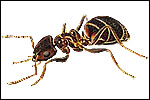
Size..
Workers 5mm overall body Length. Queens about 15.mm
Markings..
Varies in colour, usually dark brown/black.
Location..
Numerous habitats – houses gardens, factories, etc.
Detection..
Visual sightings of adults often the first indication. Some earth excavation around wall edges and paving slabs are also a sign. ‘Ant eggs’ (pupae) under stones etc. shows nest site.This is one of the most common British ants, found in almost all parts of the country. A hymenopterous insect, the ant enters properties through cracks in brickwork and around/under windows and doors in search of a meal. It causes annoyance when found feeding on our food, often causing people to throw away products found to be infested. However, they are not known to carry disease organisms.
Biology..
The ubiquitous ants make their nest in the soil, on grassland including lawns, at the base of walls, under flat stones and sometimes in hollow trees. Nests are often very numerous near buildings and occasionally may be situated close to or actually in the foundations.
The foraging workers follow fairly well defined trails to their feeding grounds which may be many yards from the nest. They have varied feeding habits. They may enter buildings, often through very narrow crevices, and if food, especially sweet food, is found by one ant there will soon be many others to share the feast. Houses, restaurants and food shops, office buildings and hospitals etc. may be entered this way and the ants may cause a considerable nuisance and some damage but their nests are usually outside the buildings.
Much can be written about their lifecycle, but it is suggested that the reader takes time to seek out more information on these insects. One of the most annoying stages is the mating period itself. During the summer great numbers of winged females (which are potential queens) and males are reared in the nest and on one or two warm summer afternoons between mid-July and mid-September they swarm out and take to flight often in quite spectacular numbers. This usually happens simultaneously over a wide area of country. Sometimes, if a nest is situated in the foundations, these winged ants may swarm inside buildings.
Sufferers may take comfort in the knowledge that the trouble will soon cease. During the flight, the ants mate. Many thousands are eaten by birds and in about two or three hours it is all over; the survivors return to earth, the males soon die, the queens shed their wings and make themselves a cell, generally in the soil where they pass the winter before attempting to start a new nest the following spring. A few – but enough -succeed. Some may find shelter in existing nests but these will generally only tolerate one queen. Under favourable conditions the queen and therefore her nest, may survive for several years.
Please contact us for a free over the phone quote..
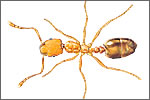
Size..
Circa 2mm (workers) Markings: Light beige, with darker head and abdomen.
Location..
Inside, in numerous locations, but must be warm (18°C+ to breed).
Detection..
Visual sightings (ant ‘trails’) of live specimens. Contamination of foodstuffs etc by dead specimens.
The Pharaoh’s Ant, as it’s name suggests, is thought to have originated in Africa, or possibly the Mediterranean area, but they are now cosmopolitan, being found in all four corners of the world. They were well known in ancient times in the Mediterranean area, but as they require a warm climate, they did not spread further north until the advent of heating in buildings. When this happened, their spread became relentless. It’s first appearance in Britain was in the early years of the 19th century. A theory exists that they came into Britain with soldiers returning from the Crimean war. Now they are found throughout the country in suitably warm premises.
Biology..
Like all ants, this species has a well developed social structure. The ant’s nest is structured around the queen. She will lay several hundreds of eggs in her lifetime of 1-2 years. These hatch after 2-4 weeks into minute whiteish larvae (‘grubs’). The larvae are tended by worker ants as .they grow, and depending on temperature, they reach the pupal stage in 2 weeks to 2 months. After another 2 weeks or so, the adult ant emerges, to take it’s place in the social structure. Worker ants will pick up and carry to safety both the larval and pupal stages if the nest is threatened. This moving process also takes place deliberately to start new colonies. During the growth of the colony, many queens (and at times, males) are produced. Often, a queen will go with the workers to start a new colony, but this is not essential – workers can create new queens and males from the developing larvae.
Temperature is very important in the life of a Pharaoh’s ant. Although they can function quite well at cooler temperatures, it must be at least 18°C to breed. The optimum temperature is close to 30°C, meaning that colonies are often sited in central heating ducts or close to pipes and boilers. Thus, their presence in centrally-heated buildings is becoming more common. It is the sterile worker ants, out foraging for food, that are most usually seen. They can be detected many metres from the nest site, following pheromone trails laid down by other workers. Ants can communicate on a number of levels, passing on information such as the location of food etc.
Reasons for Control..
Pharaoh’s Ants are thought to be frequent carriers of disease. Pathogens may be picked up as the ants forage – their very small size and their strong jaws mean that they can get inside many products. Thus they either damage the goods or become a foreign body contaminant. In areas such as hospitals, they can move from dirty, unsavoury areas to clean (possibly even sterile) areas very easily. In addition, the very presence of the insects is unpleasant. Some say they also have a pungent and distasteful odour.
Please contact us for a free over the phone quote..

Size..
All British bats are very small, ranging from 5 – 30 g (about 1/6 – 1oz.) Their proportionally large wings make them appear much bigger than they really are.
Location..
In summer bats may be seen flying and feeding wherever insects are plentiful, in and around suitable woodland, over rivers and lakes, in gardens and around Street lights. During the year they use many roost sites, and are usually only noticed in buildings during summer, when females need somewhere warm to raise their young.
Detection..
Bats neither make nests nor cause structural damage, and in many cases there is no sign of their presence. They are rarely to be seen in the roof void, as most species tuck themselves into crevices. The key identification feature is the presence of droppings. These are brown or black, 4mm-8mm. in length, the same size or larger than a mouse dropping. They crumble easily to a powder made up of insect fragments, unlike the hard droppings of rodents. Sixteen species of bat live in Britain, varying in colony size, behaviour and roost preference. Whilst Pipistrellus and long-eared bats are those most commonly found in houses, all British species have been known to use buildings, probably because their natural roosting places in tree-holes and caves are becoming more scarce and prone to disturbance. A worrying decline in their numbers led to the protection of all bats and their roosts in 1981.
Biology..
In summer pregnant females gather at a ‘maternity roost’ site to give birth and rear their young. A bat mother normally has only a one infant in a year, which is suckled on milk for several weeks until it can fly and feed itself. Huge numbers of insects are eaten to supply the energy demand of these tiny flying mammals. These are hunted using echolocation, a system by which the bats make high-pitched sounds and gain a picture of their surroundings by listening to the returning echoes. In late summer and autumn the bats move away from the maternity roost, feed well and search for winter sites. In winter, when prey is scarce, they hibernate singly or in small groups in cool humid places like tunnels, caves or old buildings. Individuals are sometimes found in cool parts of buildings.Bats are long-lived animals. Some have been known to live for over 30 years, but their habit of gathering in maternity roosts in houses and slow reproductive rate makes them very vulnerable to toxic chemicals or disturbance.
Bats in buildings..
The common Pipistrelle, the species found most regularly around buildings seem to prefer to roost inside the wooden boxed-in eaves of modern style houses and bungalows. They usually occupy the highest position, the apex at the gable end, entering through a gap between the soffit and the house wall – less than 1.5 cm is sufficient. Spaces behind hanging tiles and ship-lap cladding are also popular.
Long-eared bats prefer older places with large attics. They roost on the ridge beam or at hip joints, but tuck in against rafters where they can be overlooked. Sometimes they roost above the ridge beam under the ridge tiles and are impossible to see.Some bats may be found in the attic next to the chimney stack and roof, or inside cavity walls or an unused chimney. Other roosting sites include spaces behind window and door frames, and gaps between felt or under boarding and tiles or slates.
Legal Protection..
All 16 species of British bat are protected by the Wildlife and Countryside Act 1981 through inclusion in Schedule 5. The Conservation (Natural Habitats etc.) Regulations 1994 (Schedule 2) reinforces this Act and removes the word ‘intentional’ from the clause relating to damage to places used by bats. These make it illegal to: kill, injure, capture or disturb bats, obstruct access to bat roosts, damage or destroy bat roosts. In this context ‘damage’ means make worse for the bat and so would include such operations as treatment with toxic chemicals found in wood preservatives, or chemicals used to eradicate pests such as cluster flies.
Under the law, a roost is any structure or place used by bats for shelter or protection. It is important to note that because bats tend to re-use the same roosts year after year, the roost is protected whether the bats are present at the time or not although defences are provided by the Act so that building, maintenance or remedial operations can be carried out in places used by bats, these cannot be relied on unless the relevant Statutory Nature Conservation Organisation (SNCO, see below) has been notified and allowed time to advise on whether the operation should be carried out and, if so, the method to be used and the timing.
Best practice guidelines for control of pests in bat roosts..
The control of pests such as wasps, bees, hornets, cluster flies and rodents may unintentionally affect bats or their roosts, so care should be taken when controlling pests in an area where bats are, or are known to have been, present.
In order to work within the law, seek advice from the appropriate SNCO in any situation where an operation may affect bats or their roosts. Rodenticide’s should not be placed in an open tray below roosting bats. Insecticides recommended as safer for use near mammals are based on permethrin and cypermethrin. Details may be obtained from SNCOs. Ask advice too on the range of fungicides approved for use in sites by bats. If operations have already started when bats or their roosts are discovered, work should stop and the relevant SNCO contacted at the first available moment.
Who to contact..
The main branches of the four SNCOs are English Nature (EN), Northminster House, Peterborough PE1 1UA Tel: 01733 455000Countryside Commission for Wales (CCW).
Plas Penrhos, Fford Penrhos, Bangor, Gwynedd LL57 2L0. Tel: 01248 370444Scottish Natural Heritage (SNH), 12 Hope Terrace.
Edinburgh EH9 2AS Tel: 0131 4474784Department of the Environment, Environment Service, Commonwealth House, 35 Castle Place, Belfast N.l. BT1 1GH.
Tel: 01232 251477.
This information has been prepared by The Bat Conservation Trust. BCT is the only national organisation solely devoted to the conservation of bats and their habitats. The BCT offers advice not only to professionals likely to come across bats an bat roosts in the course of their work, but also to the general public when they find they are host to a bat colony.
BCT also supports over 90 voluntary local bat groups around the UK.Send for further details and an information pack on Bats in Buildings to The Bat Conservation Trust, 15 Cloisters House, 8 Battersea Park Road, London 5W8 4BG. Tel: 0171 627 2629e-mail: enquiries@bats.org.uk web site: http://www.bats.org.uk
Please contact us for further information.
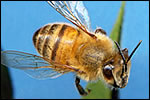
Size..
Worker 13-15mm / Drone 15-18mm/Queen 15-19mm
Markings..
Characteristic black and yellow / orange striped abdomen, black head and thorax.
Location..
Roof spaces, cavities, voids, chimneys, hollow trees etc.
Detection..
Visual sightings of bees and their flight paths or swarms by technician or customer. Occasionally dead workers or drones under entrance.
Biology..
There are approximately two hundred and fifty species of bee, although only thirty species form “social orders”. One of these is the honey bee. The bee is a member of the vast order known as Hymenoptera, the most intelligent and organised of the insect world.
Honey bees are social insects with a strict caste order with queen, drone and worker, all having a specific function within the community. The bees travel from the hive to flowers during good flying weather gathering pollen and nectar, using it as a food source for themselves and for the other members of the colony. It is this trafficking from flower to flower that is so beneficial as it pollinates many flowers and trees.
Queen Bees. There is only one queen bee per hive during most of the year. In appearance she is slightly longer in the body than the worker but has noticeably smaller wings and she possesses a sting. The queen’s purpose is solely laying eggs in the cells made by her workers; she never leaves the hive in search of pollen and nectar. She is fed food, called bee-milk or chyle by nurse bees.
Within the honey bee’s strict caste order the queen is at the highest level and is shown a great deal of respect by the worker bees. They follow her wherever she goes allowing her clear space to walk in the congested hive.
Drone Bees..
Drones are fertile male bees. They have much the same appearance as the worker bee but are slightly longer, and do not have the ability to sting. They, like the queen, do not collect pollen and nectar and take no part in the production of honey and the construction of cells. In fact after the swarming’ period is over, they die or are put to death and no more are allowed to develop until the following spring.
Worker Bees..
Workers are slender and small occurring in great numbers in the bee colony. They are the labourers of the bee world, undertaking many duties in the hive, including collecting pollen and nectar, constructing cells, tending the queen, guarding the hive and nursing the many eggs and grubs (pupae). They are not normally aggressive but possess the ability to sting.
Swarming Bees swarm together in the late spring and early summer usually around the months of May and June in order to produce new colonies. Bees swarm when there is competition in the hive from a new queen produced in the cells by the workers feeding ordinary worker pupae on a secretion called hypopharyngeal, commonly known as Royal Jelly.
This prolonged feeding allows the common worker pupa to emerge as a Virgin Queen, who is a direct threat to the existing breeding queen, disrupting the strict social order. When this occurs a swarm of bees leaves its present colony in search of a new location. When they find a suitable site they form a tight mass of bees with the queen guarded in the centre. It is this massive cohesion of bees that many people are alarmed by, seeing them clinging to bushes, trees, fences etc.
Please contact us for further information.
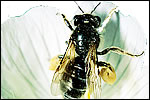
Size..
Up to 20mm overall body length. Two pairs of wings.
Markings..
Variously marked, with characteristic bee like features common, but not universal.
Location..
A wide range of man-made and natural structures from soft it to sand dune.
Detection..
Visual sightings of adults. Holes in materials and ground.
There are a number of solitary types of wild bee species, including Mining Bees, Mortar or Masonry Bees and Carpenter Bees. Their habitat can be as diverse as earth banks, soft eroded rocks, brickwork, soft or poor quality mortar and dry soft timber. They are all solitary types in as much as they do not form distinct social colonies, although many individual bees will often attack the same area if it provides particularly suitable conditions.
Biology..
The biology of these species is basically similar to that of the bumble and honey bees, but without the communal nests so typical of bee activity. All bees have four transparent membranous wings (the hind pair are much smaller than the front pair). Like all hymenoptera, they have a complete metamorphosis (egg, larva, pupa, adult). Many species mate and then over-winter, beginning the cycle again in the spring.
The body is generally hairy to assist in pollen gathering. Pollen is carried back to the nest attached to the broad and hairy hind legs. Some species carry their pollen on the underside of the body, others in the crop. Only the females are equipped for carrying pollen. All species feed off pollen and nectar, but the range of plants they favour is enormous; hawthorn, sallow, bryony, bramble, blackthorn, speedwell and dandelions form just a part of the huge number of species that the solitary bees use as a food source.
Reasons for control..
Damage is caused by the female bees boring into the material to form a system of galleries or tunnels in which to house the pupal cells of the next generation. The gallery construction takes place during the early spring and the burrowing and emergence activities are completed by early summer. Only a single brood generation is raised each year so, although the bees may be evident during the summer because of more frequent flights, the building fabric will not suffer further damage until the following spring.
The gallery system constructed by a single bee will not cause any significant deterioration of the building’s fabric. However, the brood raised in one year may over winter within the galleries and in the following spring, enlarge them or construct new ones. Over a period of a few years large numbers may become established in a small area. In these circumstances damage can become much more severe and in extreme cases has been sufficiently bad to require some re-building. In cavity walls the bees may construct cells within the cavity and on occasions have caused nuisance by gaining access to the interior of buildings.
Please contact us for a free over the phone quote..
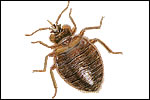
Size
4-7mm overall body length.
Markings
Light beige, but dark mahogany in colour once fed.
Location
In construction/furniture, beds, headboards etc.
Detection
Visual sightings of adults. Blood (Faecal matter) spotting, Complaints of bites around neck and waist. Unlike other species of bugs, the bed bug is wingless. It is thought that the species came form Asia, but they are now cosmopolitan, being found in all four corners of the world. They were well known in ancient times in the Mediterranean area, but as they require a warm and dryish climate, they did not spread further north until the advent of heating in buildings. When this happened, their spread became relentless.
Biology
Contrary to popular belief, mating takes place off the host in a dark harbourage. The female will lay up to 200+ eggs in small batches of about half a dozen a day, attaching them to the surface as she moves along. This species requires a minimum temperature of at least 11°C to hatch successfully.
Bed bugs show an incomplete lifecycle; that is when the egg hatches, a small nymphal form of the bed bug emerges, rather than a larval stage. The nymph will go through five or six moults, becoming larger each time, until it reaches the mature adult. The full maturation process takes from 6 to 18 months depending on the temperature and the abundance of food.Bed bugs are blood feeders, and have a sharpened proboscis to enable them to take a blood meal from the host.
They do not feed exclusively on man, but will also feed on dogs, cats and even rodents. They will take up to seven times their own body weight in blood at any one sitting, but this may have to last them for some time. A feed takes about ten minutes.
Bed bugs can go for many months without food.They can crawl appreciable distances, but their senses are not capable of guiding them to a host until they come within 20cm (8″ or so) of their chosen host. The urban myth that they hang from the ceiling is not true – they can walk upside down but will fall accidentally on the person below.
Reasons for Control
Bedbugs are not thought to be frequent carriers of disease, but some pathogens may be transmitted during the biting action. The main reason for their control are their bites – they release an anti-clotting agent which causes a severe itchiness. The very presence of the insects is unpleasant, and they also have a pungent and distasteful odour. Added to this is the social stigma of neighbours and others knowing that you have an infestation. This is often associated with uncleanliness, but bedbugs are not fussy, and will just as happily feed off clean skin.
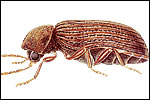
Description Order
Coleoptera (‘sheath wings’)
Characteristics
Forewings hard and leathery, meeting along mid-line of dorsal surface; hindwings membranous, sometimes lacking; biting mouthparts; well developed thorax; complete metamorphosis with egg, larval, pupal and adult stages.
Family: Anobiidae
Antennae of commonly encountered species 11 -segmented with loose club-like tip; prothorax more or less covering downward-turned head; 5-segmented tarsi.
Species Characteristics
Biscuit Beetle (Drug-Store Beetle) (Stegobium paniceum) Adult, 2-3.5mm long; colour, reddish-brown; body has dense covering of short yellowish hairs; base of thorax not humped.
Related species are the Tobacco beetle (Lasioderma serricume) and the Common furniture beetle (Anobium punctatum).
Distribution
The Biscuit beetle is a cosmopolitan pest. It is widely found in shops and domestic larders, infesting a wide variety of dried vegetable matter. In a warm atmosphere there may be as many as four generations per year.
Significance
Stegobium paniceum is a pest of cereal products, e.g. flour, bread, breakfast cereals, spices, beverage concentrates and even drugs – indeed there have been reports of it infesting poisonous substances such as strychnine, belladonna and aconite. Infested products may lose value or cause contamination of other products and packaging may be damaged, the larvae reputedly being able to penetrate tinfoil and sheet lead. Books and manuscripts may also be attacked.
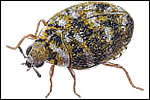
Size
2-4mm overall body length.
Markings
Thorax / elytra have white/beige/brown/black mottled markings to give a ‘camouflage’ appearance. Larval stages are small and hairy.
Location
Window ledges, under legs of furniture, root spaces (bird’s nests), carpets, clothes, furs and stuffed animals.
Detection
Visual sightings of adults or larvae. Chewed fibres and fabrics, often around fixtures and fittings. Cast larval skins.
Carpet beetles are found widely throughout Europe. There are several species of carpet beetle, including the two-spot carpet beetle (Attagenus pelio), the furniture carpet beetle (Anthrenus flaviceps) and the varied carpet beetle (Anthrenus verbasci).
The varied carpet beetle is the most commonly found infesting homes, and flies readily from site to site. The adult beetle is about 3mm in length and is dark brown, mottled with white or yellowish patches.
Biology
Adult beetles live out of doors, but females fly to lay between 50 and 100 eggs indoors on food material. These eggs hatch into the larval stage commonly known as the Woolly Bear’. The larvae are about 5mm in length and covered in tufts of arrow headed bristles which give rise to the common name.
During this larval stage the larva has between five and twenty skin moults. The larvae can remain at the larval stage for over 100 days depending on food supply and temperature. Pupation into the adult form occurs during the last of these skin changes.
Feeding Habits
The adult beetles live on plants, feeding on pollen and nectar of eg. Hogweed or Spirea. They enjoy bright warm conditions and cause no noticeable damage. The larvae (Woolly Bears) feed on natural materials of animal origin such as bird nests and woollen carpets. During the long larval stage damage to clothing and furnishings made of natural fibres may be noticed. All natural fibres in the building should be examined to establish the extent of the infestation.
Signs of Infestation
After the adult female has laid her eggs in the home she may be noticed on window boards attracted by the natural light, wanting to return to the plants and flowers outside which are her food source.
The larvae will be deep into their feeding material and are not sighted until very noticeable damage occurs to household furnishings. Cast larval skins may be evident, but will need in-depth inspection, as they are small and are usually in cracks and crevices. When checking for carpet beetle activity, it is important to lift and move as many of the items of furniture, furnishings and fabrics as possible, otherwise potential harbourages may be missed, and the infestation will quickly re-establish.
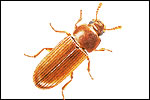
Description Order
Coleoptera (‘sheath-wings’)
Characteristics
Forewings hard and leathery, meeting along mid-line of dorsal surface; hindwings membranous, sometimes lacking; biting mouthparts; well developed thorax; complete metamorphosis with egg, larval, pupal and adult stages.
Family: Tenebrionidae
Usually 11 -segmented antennae; front and middle tarsi are 5-segmented and hind tarsi 4-segmented.
Species characteristics
Confused Flour Beetle.
(Tribolium confusum) Adult elongate, 2.6-4.4mm in length; colour, reddish-brown; antennae with loose, indistinct, 5 or 6 segmented club which may be lacking; slight ridge evident above each eye.
Rust-Red Flour Beetle (Tribolium castaneum)
Adult elongate, 2.3-4.4mm in length; colour, reddish-brown; antennae with distinct, 3-segmented club at tip; no ridge present above each eye.
Dark Flour Beetle (Tribolium destructor)
Adult elongate, 4.5-5.75mm long; colour, black or very dark brown.
Small-Eyed Flour Beetle (Palorus ratzeburgii)
Adult elongate, 2.4-3mm long; eyes small and round; antennae with no well-marked club.
Long-Headed Flour Beetle (Latheticus oryzae)
Adult elongate, 2.6-3mm long; colour, pale yellow; antennae with compact 5-segmented club.
Broad-Horned Flour Beetle (Gnathocerus cornutus)
Adult elongate, 3.5-4.9mm long; male with conspicuously enlarged, toothed mandibles, broader at base than near apex.
Slender-Horned Flour Beetle (Gnathocerus maxillosus)
Adult elongate, 3-4mm long; male with conspicuously enlarged, toothless mandibles, slender and in-curved.
Distribution
Flour beetles are cosmopolitan. Two of the most common species are the Confused flour beetle, which is commonly encountered in bakeries and flour mills, and the Rust-red flour beetle. Both are serious pests of cereal products, including grain, flour, porridge oats and rice bran.
Other products which may be attacked are oil seed, oil cake, nuts, dried fruit, spices, chocolate – even bones and other animal products. The beetles are not cold hardy, so they will only over winter under warm conditions. They are active insects which will seek cover if disturbed and, because they are so small, can exploit the smallest crevice. They are a particular problem in machinery where cereal and other food residues accumulate.
Significance
Flour beetles are generally recognised as secondary pests of grain and therefore increase the feeding damage done by primary pests. When present in large numbers, flour beetles will:
I) Cause flour to become prone to
moulding and will also turn the product grey;
II) Taint commodities with secretions
from scent glands.
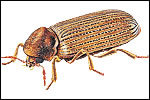
Size
3-5mm overall body length.
Markings
Adults mid-brown in colour, but not shiny. Larval stages are white/straw coloured.
Location
Timber, both in the wild and in construction/furniture etc.
Detection
Visual sightings of adults. ‘Sawdust’ on the floor under exit holes. Use of pheromone ‘Anobid’ traps.
The furniture beetle, also known as wood worm or the woodworm beetle, is widespread throughout Europe, including the UK. Originally a ‘wild’ species found in dead and fallen timbers. It is widespread outside, attacking window and door frames and wooden posts. Like many insects it has adapted to the human environment, and has become a pest of timbers in houses, planes and boats.
Biology
It is typical to see the adult stages from Easter into early summer, when they emerge and take to the wing for mating. About 30 or so eggs are laid in cracks and crevices on the wood from which the female has emerged or onto the end grain of sawn timber. It has been known for the adult emergence holes to be re-used for egg laying. Depending on temperature, the eggs hatch in two to four weeks. The young larval stages burrow straight down into the wood for protection and food. If the tunnels are examined, they will be random in pattern, although they often follow the line of the grain. Furniture beetle will attack both soft and hardwoods, but it is mainly the ‘sapwood’ that is attacked.
Development to adult depends on timber type and temperature, but takes at least two years in buildings, and can often take much longer. The final stage (final instar) larvae burrow towards the surface, but do not emerge. Instead, they construct a pupation chamber just below the surface. After pupation, the new adult emerges by biting the cap off this chamber, leaving the typical ‘woodworm hole’ of about 2-3mm diameter.
Reasons for Control
The furniture beetle is an important and serious pest of timbers, both structural and decorative. In addition, it attacks furniture and other wooden goods. Varnished or polished woods are not usually attacked, but the infestation may have arisen before the item was made, and even the best furniture has joints and unfinished areas such as drawer backs and bases.
Obviously, the visible signs of woodworm activity can ruin wooden items (although some antiques are enhanced by signs of historical furniture beetle activity). Where structural timbers are affected, serious weakening can occur, resulting in expensive repair work or even demolition.
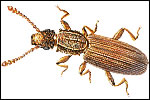
Description Order
Coleoptera (‘sheath-wings’)
Characteristics
Forewings hard and leathery, meeting along mid-line of dorsal surface; hindwings membranous, sometimes lacking; biting mouthparts; well-developed thorax; complete metamorphosis with egg, larval, pupal and adult stages.
Family: Silvanidae
Narrow, flattened insects with 11 -segmented, clubbed antennae and 5-segmented tarsi.
Species characteristics
Saw-Toothed Grain Beetle (Oryzaephilus surinamensis)
Adults, 2.5-3.5mm long; colour: dark brown; distance from eye to prothorax more than half vertical diameter of eye; 6 teeth along each side of prothorax (hence the name( ‘Saw-toothed’).
Merchant Grain Beetle (Oryzaephilus mercator)
Very similar in appearance to Saw-toothed grain beetle with the characteristics described above, except that distance from eye to prothorax less than half vertical diameter of eye.
Foreign Grain Beetle (Ahasverus advena)
Adults, 2-3mm long; colour: reddish-brown; sides of prothorax not toothed but each apical angle of prothorax has single large tooth.
Distribution
As indicated by its species name, which is taken from Surinam, the Saw-toothed grain beetle probably originated from the Americas. It is now cosmopolitan in distribution.
The species will infest cereals and a wide range of foodstuffs. Retail premises and warehouses can suffer infestations and the beetles will frequently appear in packaged food. Infestations arise from the presence of insects in the fabric of grain stores (including sacks), in grain being transferred from one establishment to another and in vehicles used for transportation. Relatively small numbers of insects can rapidly give rise to serious infestations. They are small, active insects which readily exploit cracks and crevices where they can hide. Being cold-hardy they are able to over winter in temperate lands without difficulty. Their life-cycle may be completed in as little as 20 days and serious outbreaks may occur within a month of harvest.
The Merchant grain beetle is also widely distributed. Like the Saw-toothed grain beetle, it too will infest a wide variety of foodstuffs. However, since it is more sensitive to low temperatures and humidities, infestations only become established in heated buildings where suitable conditions exist.
The Foreign grain beetle also originated in the tropics. It is capable of infesting a variety of materials but only in the presence of moulds.
Significance
Saw-toothed grain beetles are potentially important pests of farm-stored grain. They also infest cereal products, dried fruit, dried meats, oilseeds, nuts, rice and even drugs.
In grain, the mere presence of insects may result in its rejection. The germ may be damaged and when infestations become heavy they cause the grain to heat. This in turn leads to caking, moulding and even sprouting. Both the quality and weight of the grain may be reduced. Malting barley may be rejected because of poor germination, whilst milling wheat is adversely affected by tainting and discoloration.
The presence of insects in other foodstuffs will render them unpalatable and cause their rejection.
Merchant grain beetles mainly infest oilseeds and dried fruit whilst Foreign grain beetles attack cereal products and cocoa as well as these commodities.
Life-Cycle
The female Saw-toothed grain beetle lays up to 400 eggs, either singly or in small batches, at a rate of 6-10 per day. These are laid in, or adjacent to, a suitable food supply and at a temperature of 20-23°C hatch in 8-17 days to give flattened larvae about 0.9mm long. They are yellowish-white in colour, with brown flecks and a brown head.
Typical of coleopterous larvae, they have a well-developed head, biting mouthparts and 3 pairs of legs on the thoracic segments. The larvae are active and feed on damaged grains, so they can be regarded as secondary pests of grain. The larval stage lasts 4-7 weeks during which the larvae go through 2-5 moults, attaining a length of 3mm. They then construct a cell of food particles and other debris in which to pupate, emerging after 1-3 weeks as adults.
On emergence the adult beetles live for 6-10 months, breeding within a temperature range of 17.5-40°C. At 20°C the full life-cycle is completed in 12-15 weeks whilst at 32-35°C it takes only 20 days.
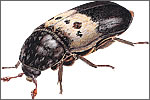
Size
7-9mm overall body length.
Markings
Adult fleas are dark brown in colour with characteristic whitish speckled transverse band across the elytra (wingcases).
Location
Poultry units, piggeries, under furniture, roof spaces (bird’s nests) and underneath kitchen units, fridges and freezers etc.
Detection
Visual sightings of adults. Chewing of leather, wood and other natural fibres.
This species is one of the group known as Hide Beetles, and is found throughout Europe. It is particularly widespread in the UK. They occur naturally in birds’ nests and favour a high protein diet made up of materials of animal origin.
Biology
Adult female Larder beetles lay from 200 to 800 eggs on or near to the food substrate. These hatch out in about a week, depending on temperature. The larval stages are small and densely haired (bristled), and are surprisingly fast-moving. After several skin moults and a period of about two months, they move out of the food source and seek a hidey-hole in which to pupate. Commonly, they will bite their way into wooden panelling or posts and create pupation chambers. Pupation occurs and the adult beetle emerges, followed fairly quickly by mating. The entire life-cycle takes 8-12 weeks at temperatures of 17-24~C.
Reasons for Control
Apart from the damage they can cause to foodstuffs, this beetle can attack stored items in museums, furs, stuffed animals and similar goods, In houses, they can often damage skirting boards and door frames when creating pupation chambers. They are also a major pest of farms. In poultry units and piggeries the larvae bore into structural timbers and insulation to pupate. This obviously damages buildings and reduces the thermal efficiency of the polystyrene insulation. They do burrow into glassfibre insulation, but this has little effect on it’s insulative properties.
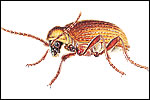
Characteristics
Forewings hard and leathery, meeting along mid-line of dorsal surface; hindwings membranous, sometimes lacking; biting mouthparts; well developed thorax; complete metamorphosis with egg, larval, pupal and adult stages.
Members of this family possess long, 11 -segmented antennae, positioned between the eyes, plus a number of characteristics which give them a spider-like appearance: a stout body with hairy surface; a waist-like constriction at the base of the prothorax;
6 (not 8) long thin legs with 5-segmented tarsi.
Species characteristics
Australian Spider Beetle (Minus tectus).
Adult, 2.5-4mm long; elytra clothed with dull-brown to golden-brown hairs; striae not distinct unless hairs rubbed off.
White-Marked Spider Beetle (Ptinus fur)
Adult, 2-4.3mm long; red-brown with yellow hairs; prothorax with dense cushion of pale hairs on each side; elytra with white scales; striae visible.
Golden Spider Beetle (Niptus hololeucus)
Adult, 3.0-4.5mm long; elytra and thorax clothed in silky golden-yellow hairs and fine scales.
Hump Spider Beetle (Gibbium psylloides)
Mite-like appearance, 1.7-3.2mm long; colour, shiny red-brown to black; lacks characteristic waist-like constriction; devoid of hairs.
Distribution
Ptinus tectus originated in Australasia. It is a cosmopolitan species which reached Europe in the 19th century and is now widely distributed. It is rarely imported and infestations often originate in birds’ nests. There are 2-4 generations per year in unheated conditions. All stages except eggs and young larvae can overwinter.
Ptinus fur is a closely related species which is also cosmopolitan in distribution. The Golden spider beetle has similar feeding habits to the Australian species, exhibits a preference for moist places and will occasionally infest textiles, especially if soiled with grease. It is increasingly common in domestic premises. There is usually one generation per year in unheated conditions in temperate lands and peak activity is reached between August and November. Gibbium psylloides. This insect is tolerant of cool conditions and can survive for long periods without food supplies.
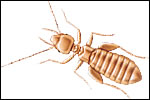
Description Order
Psocoptera (‘winged like Psocus’ with ability to grind to pieces).
Characteristics
Soft-bodied insects, rarely exceeding 6mm in length. Typical forms have two pairs of membranous wings, but there is an evolutionary tendency to loss of wings in many species. Antennae long and threadlike, with 12-50 segments; compound eyes, poorly developed; biting mouth parts; tarsi 2 or 3 segmented, each bearing two claws; incomplete metamorphosis with egg and nymphal stages.
Species characteristics
Liposcelis bostrychophilus (bostrychophila)
Adults about 1 mm long; colour, light brown; broad, flat hind femur; no wing rudiments; abdomen flattened.
Liposcelis entomophilus
Colour, yellowish brown, with conspicuous dark reddish bands across abdomen.
Death Watch (Trogium pulsatorium)
Adults very active, about 1.5-2.0mm long; pale yellow or white in colour; well developed eyes; wing flaps present; rows of dark spots on front margins of some abdominal segments.
Lepinotus patruelis
Adults about 2mm long; colour, dark brown or black; wing flaps present.
Distribution
Most booklice species are found in natural habitats such as animal nests, tree trunk crevices, under bark (hence the alternative name of barklice) and on leaves. However, those species that have achieved pest status are widely distributed and often found in warehouses, food manufacturing premises, granaries and museums as well as domestic and retail premises. Here they will infest materials of plant and animal origin including stored food, plaster, leather, woodwork and even books.
Many species are cosmopolitan and their countries of origin are unknown. Different species exhibit different temperature requirements. Thus Lepinotus patruelis is frequently encountered in cool situations, e.g. warehouses, whilst Liposcelis bostrychophilus, which is thought to have originated from Africa, prefers warmer situations. In heated buildings continuously brooded species (e.g. Liposcelis spp.) will continue to breed throughout the year. Other species (e.g. Trogium spp.) produce only one generation per year and may overwinter as nymphs.
Significance
Psocids rarely cause damage directly by feeding and are virtually harmless in small numbers. Large infestations, however, may cause significant damage to delicate materials such as books and furs. Signs of spoilage of dried meat have included holes and tunnels in which the insects hide plus a covering of white powdery material and salt crystals.
The major problem posed by psocids is the nuisance which they cause. The insects will contaminate raw or processed foods. They may contribute to a gradual heating of grain stored in bulk with an eventual impairment of its properties and reduction in its value. Contaminated products must be identified and destroyed, which is time-consuming and wasteful. Eggs may be downgraded because of spotting caused by the crushed bodies of dark booklice, e.g. Lepinotus spp. Finished products may be infested in retail premises or in the home, with a consequent loss of goodwill. Pallets, damage and packaging may be infested and act as a source of infestation of stored products.
Among the wide variety of commodities and materials which may be infested by psocids are the following: bagged nuts, bat guano, chocolate, fish meal, milk powder, museum specimens and books, oil seeds, processed cereals, pollen, salami, skin scales, Springbok biltong, stored cereal grains, sugar beet seeds, yeast and even damp plaster.
Although harmless to man, booklice are often confused with true lice and therefore regarded with alarm. As well as infesting foodstuffs in the home they may be encountered swarming over furnishings and walls, including newly plastered surfaces which are still damp. Clearly, materials of both animal and vegetable origin may be attacked but the insects show an undeniable preference for micro-organisms, including bacteria, yeasts, moulds and algae, and populations will develop more successfully in damp conditions where these thrive. This close association with micro-organisms results in these becoming entangled in their bodies and in this way the insects are instrumental in disseminating the organisms which cause spoilage.

Size
Unknown (usually thought to be very small).
Markings
None that are visible. Location: Anywhere, but often in Hi-Tech office blocks.
Detection
Customer will complain of “being bitten”, but no obvious signs of insect activity seen.
Biology
Let’s set the record straight -there is no such thing as cable bug! The animal known as cable bug is a mysterious creature, as it has never been seen. It has many common names including “Paper Mite” and “Biting Mite”, and is often confused with infestations of true biting insects such as fleas or midges. This is because the cable bug appears to bite people in a similar manner.
In reality, the biting sensations are caused by static electricity, not by any insect or mite. There are two types of cable bug phenomena; that caused by a discharge of static electricity alone, and that caused by the static charge acting on paper fibres and the like. Explaining them is not easy:
1) Static Charge When a person is moving around in an office environment, they are usually surrounded by lots of electrical equipment. Added to this is the material of the carpeting (often synthetic) and the abundance of metal – framed desks, chairs and cabinets. In short, the individual builds up a static charge on their body through actions such as shuffling along the carpet.
They then move to a metal-framed cupboard or sit at a metal-framed desk. The result of this close contact is that a charge of static electricity arcs across person to the desk or vice-versa. This ‘zap’ or ‘belt’ of static feels just like an insect bite – a characteristic ‘sharp’ sensation, followed by itching and discomfort. Inspection of the ‘bite’ reveal the typical signs of an insect bite – a raised redness of the skin, and even a pale white centre at the site of the ‘bite’. BUT, there is no puncture mark (ie: no hole where biting or piercing mouthparts have broken the skin).
2) Charge plus Fibres There is some evidence to suggest that a second phenomenon involved with static electricity may occur. In environments offices, filing/ record rooms and document stores, there are often an abundance of very small fibres. In situations where static electricity may build up, the also become charged, and thus can become ‘miniature javelins’. These can embed themselves in the skin, and whilst they are easily brushed off by the scratching, they also give the characteristic ‘biting’ sensation.

Size
40-80cm overall body length.
Markings
Cats come in a wide variety of colours from white to black via tabby.
Location
Office blocks, hospitals, prisons etc.
Detection
Visual sightings of adults and kittens, smell, droppings.
The feral cat is a small carnivorous mammal. It’s ancestor is believed to be the African Wild Cat (Fells llbyca), although many scientists think this is simply a race of the European Wild Cat (Fells sylvestris) of Europe and Western Asia. All cats belong to the family Felidae. A feral cat is not a different breed of cat; merely a domesticated cat which has become wild’ and now fends for itself.
Biology
All cats walk on the pads of their toes and have retractile claws. The canine teeth are long and well developed, as are the shearing teeth in the side of the mouth. The limbs are strong and are good for springing or short bursts of speed. The eyes are large and forward-facing, and the hearing acute. Feral cats are well-camouflaged and highly adapted for their role as stealthy hunters. They are, of the mammals, one of the most committed to a carnivorous diet.
It is possible for cats to have more than one litter per season, resulting in quick explosions in numbers. Litter sizes are very dependant on the availability of foodstuffs, but double figure litters are not unknown.
Reasons for Control
Cats are natural hosts for that old favourite of the pest controller – the flea. Cat fleas can be carriers of serious bacterial diseases and are vectors of tape worms to domestic animals and humans. In recent years flea infestations have increased due to a number of reasons, including central heating, fitted carpets (especially long pile) and increasing numbers of feral cats can lead to large number of fleas which then begin affecting humans.
In addition to fleas, feral cats cause problems by their screams and cries, and from the stench of their droppings. The notable odour from the male cat’s (Tom) urine does not have to be discussed at length here. Feral cats can also upset or eat domestic and farm birds, wild birds and small-rodents including domestic pets such as gerbils and hamsters. Furthermore, they cause problems by damaging domestic refuse sacks, leading to spillages etc.
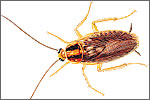
Size
11- 16mm overall body length.
Markings
Light beige, with two dark stripes on the pronotum behind the head.
Location
Numerous locations, usually close to food and water.
Detection
Visual sightings of adults and nymphs. Odour. Faecal spotting. Egg cases.
The German cockroach, also known as the steamfly (due to it’s liking of hot environments) is thought to have originated in North East Africa, but now can be found in virtually all parts of the world. It prefers warm moist conditions (25- 300C) and has consequently become a common pest of heated buildings, notably in kitchens, larders and restaurants. It is very prevalent in the galleys, store rooms and accommodation of modern ships. In warmer climates, such as the southern States of America, the German cockroach occurs outdoors but this is rare in Britain.
Biology
The adult German cockroach is quite small (11-16 mm), so much so that many people don’t realise it’s a cockroach at all. Both the adult and nymphs are beige coloured. Adults have two distinct dark parallel bands running the length of the pronotum, behind the head. The wings are as long as the body in the male and almost as long in the female. It is generally more active than the Oriental cockroach and more readily seen during the day.
The egg case, or ootheca is 8 mm long and is a chestnut brown colour Look carefully and you will see that it has about 18 segments. The egg case is carried by the female until the just before the eggs hatch. Oothecae are produced at about 3-4 week intervals and contain 35-40 eggs. German cockroaches have an incomplete metamorphosis (egg, nymph, adult). There are usually 6 nymphal stages, with development to the adult taking 6-7 weeks at 30°C. The adult life span is 4-5 months.
Reasons for Control
The German cockroach is now known as a major pest of buildings, particularly in warmer climates or where central heating is present. It is the second most common cockroach pest in Britain, after the Oriental. Because of its habits and feeding sites, it is a potential carrier of pathogenic bacteria when associated with food. People also find their presence and odour repulsive. A recent study in the USA suggests that nearly one fifth of the population is allergic to cockroaches.
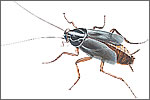
Size
18-24mm overall body length.
Markings
Dark mahogany. Adult male is winged.
Location
Numerous locations, usually close to food and water.
Detection
Visual sightings of adults and nymphs. Odour. Faecal spotting. Egg cases.
The Oriental cockroach, Black beetle, Black lock or Shad roach, to give it just a few of its common names, is thought to have originated from North Africa. It is now widely distributed in almost all temperate regions of the world, preferring less humid and cooler conditions (22-27°C) than other cockroach species such as the German, Blattella germanica, and American I Australian, Periplaneta spp. It has been shown to be able to survive the winter outdoors, notably in refuse heaps.
Biology
The adult Oriental or Common cockroach is large (20-24 mm long) dark red/brown to black. Most people would be able to recognise this species as a cockroach, unlike some of its smaller cousins. The male is winged, but the female has much reduced, vestigial wings and tegmina. However, neither sex is able to fly.
The species is principally nocturnal and so not often seen during the day – any daylight sightings suggests a heavy infestation or a newly introduced specimen searching for a harbourage. The egg case (ootheca) is about 10-11 mm long, is brown-black and deposited by the female soon after formation. Oothecae are produced at about 10-day intervals and contain about 16 eggs. Cockroaches have an incomplete metamorphosis (egg, nymph, adult). There are 7-10 nymphal stages, development to adult taking 6-12 months in heated buildings.
The adult life span varies from 2 months under warm conditions to 9 months in cool conditions.
Reasons for control
B. Orientalis is now known as a major pest of buildings, notably in cellars, basements, ducts, boiler rooms, kitchens, bakeries, toilets and bars. It is the major cockroach pest in Britain.
Because of its habits and feeding sites, it is a potential carrier of pathogenic bacteria when associated with food. People also find their presence and odour repulsive. A recent study in the USA suggests that nearly one fifth of the population is allergic to cockroaches, their droppings, odour and breakdown products.
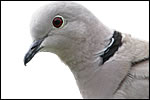
Size
28-29cm overall body length, and about 200g.
Markings
Uniformly grey/brown with a noticeable black collar.
Location
Grain stores, docks, ploughed fields, food factories.
Detection
Sightings of adults, smell, droppings, nesting materials.
Collared Doves take their name from the incomplete, white-bordered but otherwise black neck collar. The smallest of our resident dove species, they have spread from the continent and have colonised most of Britain in the last 40 years with a dramatic population explosion.
Associated closely with man and his cereal grain, collared doves are now a common sight in many villages and towns.
Biology
The birds nest in trees, with a breeding period extending from Easter until mid-October. Initially, the nest is a somewhat ramshackle affair, but it becomes refined over the course of the season. Doves lay only two smallish white eggs in the nest. Sometimes they may begin a second nest even before the young from the first nest have fledged.
Incubation of the eggs is carried out by both male and female, with an incubation period of 14 days. A fast development means that the young are able to fly after only 18 days, and they are fully fledged at 3 weeks. Like pigeons, Doves produce a protein-rich milk -a cheesy curd that sloughs off from the lining of part of the crop. This is initially all the nestlings need. Later, at feeding times, the adults regurgitate food they have gathered and stored in the crop. Young are fed twice a day in the morning and evening.
Collared Doves have a three-note cooing song which they repeat several times in succession. Male Collared Doves also have a nasal-sounding song which is often mistaken for the call of a cuckoo. A special feature of doves and pigeons is their powder down feathers – small feathers of a crumbly material that break up into a dust to help in preening other feathers. If a bird flies into a window, this dust is shaken loose, leaving a remarkably detailed ‘dust shadow’.
Reasons for Control
Doves eat a wide variety of natural foods including weeds, ivy, acorns and beechnuts, but they are primarily grain feeders, and this brings them into direct conflict with man. They often roost in parks, gardens and around domestic properties, from where they fly a short distance to the feeding site. This may be anywhere that grain or bulk grain is handled, including, mills, granaries, farm grain stores and around places where grain is fed, such as poultry units. Although there are reports of them decimating agricultural land, their field activities are mainly confined to stubble. Flocks of 400-700 birds are not uncommon, resulting in a considerable economic loss. In addition, their droppings provide a major source of contamination.

Size
15-16mm overall body length.
Markings
Varies in colour, but often reddish-brown.
Location
Slightly damp houses, shops factories, farms etc.
Detection
Visual sightings of adults. Chewed vegetable matter including wallpaper and books. ‘Skeletonized’ leaves.
Adult earwigs are of the order Dermaptera, around 16mm long with a reddish head and pale yellow-brown legs and a pair of pincers at the end of the abdomen which are used for attack or defence and to assist in folding the wings. Females have the pincers set together (above, right), whilst males are more curved (below). These pincers, more properly called ‘forceps’ can give you s slight nip, but are unlikely to break the skin.
The common earwig (Forficula auricularia) although possessing wings, rarely flies. Some say that the name originates from the shape of these wings, but folklore suggests that the insects used to harbour in the natural fibres of wigs placed by the bedside in the middle ages. When the wearer put on the wig in the morning, the creatures sought somewhere dark to hide, hence ‘ear-wig’. Those used to camping may also testify this story as the earwigs make their way inside to seek shelter.
Biology
Earwigs are active at night and hide during the day in cracks and crevices They feed on a variety of garden plants making small irregular holes in the leaves but may often be found inside houses during the day in any part of the premises providing shelter.
A male mates with only one female and after mating they hibernate in underground cells in the base of tree stumps In early spring the female lays a batch of around 50 white eggs in the cell and when the male leaves the cell, she remains to guard the eggs.
The eggs hatch into tiny adults called nymphs which are looked after by the mother until they reach maturity in June or July. The females may have more than one brood in a season, after which they die.
Earwigs may be seen indoors in cellars, hiding in laundry, inside wardrobes and even roof spaces. Damage in gardens is often noticed by skeletonized plant leaves similar to slug damage but with an absence of slime. Occasionally a nest of young earwigs squirming and writhing in a mass may be found in the garden.

Size
2-3mm overall body length.
Markings
Adult fleas are dark mahogany in colour. Larval stages are white/straw coloured, small and hairy.
Location
Carpeting, bedding, under furniture, roof spaces (bird’s nests). Any areas that pets frequent.
Detection
Visual sightings of adults. Bites, most often on the lower leg.
Fleas as adults are parasites on warm blooded animals, eg humans, cats, dogs, birds, etc. These are known as hosts. Those most commonly found in homes hospitals and offices are cat fleas, but others (dog fleas, bird fleas, hedgehog fleas and occasionally human fleas) may also occur. The historical links with the Bubonic Plague, caused by a bacterium carried by the black rat flea, are widely known. What may be surprising is that plague has not been eradicated, and can still be caught in areas such as Madagascar and some areas of the Far East.
Biology
Female fleas lay eggs of about 1mm in small batches on or near the host after a blood meal. After 2 or 3 days, the eggs develop into bristly, legless larvae. These feed on scraps of organic matter and specks of host blood passed by the adult fleas. After 3 moults and a period of typically about 3 weeks, the larvae pupate, turning into adults within days or laying dormant for many months.
Vibrations caused by the presence of a host triggers off the hatching process. Once hatched, the flea jumps towards any source of heat and vibration They also taste’ the air and detect the presence of carbon dioxide from the host’s breathe, enabling them to home-in on their target. The complete lifecycle is temperature-dependent, but in favourable conditions one pair of breeding fleas can produce 6000 off spring in four weeks.
Reasons for Control
It is important to control fleas for various medical and social reasons, i.e. fleas can be carriers of serious bacterial diseases and are vectors of tape worms to domestic animals and humans. In recent years flea infestations have increased due to a number of reasons, including central heating, fitted carpets (especially long pile) and increasing numbers of pets kept in homes (especially cats).
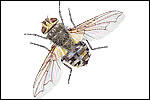
Size
6-10mm overall body length.
Markings
Reddish eyes and a thorax covered in golden hairs.
Location
Numerous locations, but usually in lofts and root spaces. South-facing walls often favoured.
Detection
Visual sightings of large numbers of adults.
There are three main species of fly collectively known as cluster flies. They are Musca autumalis, a small fly of about the same size and colour as the house fly, Pollenia rudis, a larger fly dull brown/grey in colour, and lastly Dasyhora caynella which is about house fly size and shiny green/blue in colour.
Biology
Cluster flies, particularly Pollenia rudis are very common occurring throughout Great Britain. The adult flies after hibernation during the winter months, lay their eggs in the earth or in animal dung. Permanent areas of grassland are favourite sites e.g. permanent grazed pasture or parkland as soil cultivation such as ploughing disrupts the flies breeding cycle. The eggs remain in the earth and hatch when soil temperature increases in the spring. The larval stage is parasitic, entering earthworms and feeding upon them until emerging as an adult fly.
Cluster flies migrate from outdoors into the lofts of houses and farm buildings during the winter months. Obvious signs of an infestation is a roof space containing a large quantity of lethargic flies and a quantity of dead flies. Unless the loft is used for storage purposes or is accessed regularly the flies will hibernate successfully leaving in early spring dependant on the weather.
Reasons for Control
Cluster flies are not damaging to property when they enter buildings in the autumn purely to hibernate over the cold winter months. As mentioned above they feed on decaying vegetation and earthworms. Cluster flies are not to be associated with dead animal bodies, faeces and the resulting maggots. Fibre glass insulation material in lofts can look unsightly if covered with the bodies of flies that have not hibernated successfully although its insulation properties will not be altered and no damage to the roof structure will occur.
If the loft is home to a hibernating colony of flies, first floor lighting diffusers or sunken spotlight lenses can become full of dead or dying flies. This often occurs in houses where the loft area has been converted into a living room. In most buildings built after 1950 the external roof covering has an under felt layer. Cluster flies can successfully hibernate undetected between these two layers. Often cluster flies can be seen basking on sunny grassland or resting on south facing walls of buildings. Cluster flies, like birds, return to roof spaces previously occupied so re-infestation is almost inevitable.
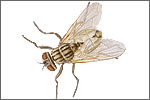
Description Order
Diptera (‘two-winged’)
Characteristics
Single pair of membranous wings; hindwings modified as halteres; suctorial mouthparts, piercing or non-piercing; large compound eyes; tarsi, 5-segmented; metamorphosis complete with egg, larval, pupal and adult stages.
Family: Muscidae
Species characteristics
Common Housefly (Musca domestica) Adults, 6-8mm long with 13-15mm wingspan; grey thorax with 4 longitudinal dark stripes; basal half of abdomen buff-coloured and occasionally transparent at sides, with central dark band broadening to cover last abdominal segments; at rest, wings are spread; venation shows a sharp upward bend of 4th vein at apical end.
Lesser Housefly (Fannia canicularis) Adults, 6mm long with 12mm wingspan; grey thorax with 3 longitudinal stripes, less pronounced than those of Common housefly; extensive yellow patch at base of abdomen; at rest, wings are folded along back; venation shows 4th vein extending straight to wing margin
Distribution
Common houseflies (M domestica) are ubiquitous insects, with a flight range of at least 8 kilometres (5 miles). They are highly active indoors. In colder climates breeding generally ceases before winter, whereupon the insects overwinter either as pupae or adults. However, in warm environments houseflies remain active and reproduce throughout the year.
Lesser houseflies (F. canicularis) are frequently encountered in poultry houses. They have an erratic flight pattern and are often seen flying in large numbers around indoor light fittings. The Lesser housefly is more tolerant of cool conditions than the Common housefly. This species survives the winter mainly in the form of pupae, although, as with the Common housefly, adults remain active and reproduce throughout the year in warm conditions.
Significance
Houseflies can transmit intestinal worms, or their eggs, and are potential vectors of diseases such as dysentery, gastroenteritis, typhoid, cholera and tuberculosis. They will frequent and feed indiscriminately on any liquefiable solid food, which may equally be moist, putrefying material or food stored for human consumption.
Flies liquefy food by regurgitating digestive juices and their stomach contents on to the food substance. This ‘liquid’ is then drawn up by the suctorial mouthparts and in so doing the insects pick up pathogenic organisms, which may collect on their bodies to be transferred on contact with other surfaces or survive passage through the gut to be deposited as fly spots. Fly spotting, produced when the insect feeds or defecates, results in rejection of contaminated farm produce, for example eggs, at point of sale. Furthermore, flies are frequently the subject of complaints to environmental health authorities, causing major problems where infestations over-spill from breeding sites such as rubbish tips and animal houses.
The Lesser housefly makes longer flights and spends less time resting than the Common housefly. Females of the species tend to remain near the breeding sites and only the males migrate. For these reasons F. canicularis is less prone to transmit disease than M. domestica, but large populations and similar feeding habits mean that this insect, too, has a considerable potential to act as a vector of disease. It has occasionally been implicated as a vector of intestinal or urinary myiasis.
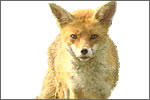
Size
100 -1 20cm overall body length (inc. tail). 40-50cm high at shoulder Weight varies, but is typically 5-7kg.
Markings
Adult foxes are red/brown in colour. Often have a white/light grey tip to the tail.
Location
A wide variety of habitats, from the deepest rural setting to the centre of a city.
Detection
Visual sightings of adults. Droppings, footprints, hair, barking. Notable musty’ odour. Damage to refuse.
The well-loved, and equally well-hated fox is found throughout Europe and across into Asia, as well as North America and North Africa. In this country it can be found in almost all environments including towns and cities, farmland, parks, golf courses, moorland and woodland.
Biology
Males (dogs) and females (vixen) tend to mate around late January/early February. Litters are born after a gestation period of 53 days, meaning that the average litter of 5 pups arrives during the beginning of April. The young are suckled initially, and weaning begins after 4 or 5 weeks. It is not unusual for the pups to remain with the vixen for over 4 months.
As well as killing live prey such as hens, ducks, rabbits and the like, the fox is very much a scavenger, and is content to feed off a variety of carrion, along with fallen fruits and spillages from bird tables. Foxes are similar to dogs in that they will eat as much as they can get, but they also seem to kill in a frenzied manner when amongst plentiful live prey. This means that they kill far more than they can eat. However, this situation is reducing as humans are now tending to live on estates rather than on small-holdings, and so have less livestock.
Reasons for Control
Foxes are often controlled more because of their nuisance value than because of any serious damage they do. Complaints can include the noise they create from their screaming and barking early in the season (around mating time), damage to domestic and catering refuse, digging and excavation in gardens, parks, golf courses and allotments, and even due to their habit of leaving food scraps around their dens.
Control is also important where foxes are becoming predators on domestic pets or on livestock such as lambs, geese and hens. Cats and foxes usually maintain a discreet distance and so do not come into conflict.
Another reason for control is the potential spread of disease from foxes to other species. The fox is the largest wildlife reservoir of rabies on continental Europe, the disease being passed on in saliva via the bite of an infected animal. Our quarantine rules have helped to ensure that the UK is currently rabies-free. A second disease that may be transmitted by foxes is sarcoptic mange, an infestation of the skin by one of two species of mites. This causes severe irritation of the skin, sometimes leading to the death of the fox. There is some evidence that mange can be passed across to dogs.
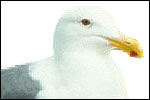
Size
50-70cm overall body length.
Markings
Pale grey body with white head. Yellow bill with a red spot at the end of the lower mandible (beak). Pink legs.
Location
Sea-side resorts, docks, ploughed fields, refuse tips etc.
Detection
Visual sightings of adults, smell, droppings, nesting materials.
The Herring gull is the most numerous of our gulls. They breed all round the coasts of Britain and Ireland, except for the stretch from Flamborough south to the Thames. (in this area only a few isolated pairs have been recorded). The further north you go, the more abundant herring gulls are. Numbers increase to over half a million pairs in winter due to visitors from north west Europe.
Biology
Herring gulls nest along the steep cliff edges, among rocks, on ledges and on stacks. During the 1920’s, a few herring gulls began to nest on buildings in south west Britain: now many more are choosing this type of nesting site. Both parents build the nest using grass, seaweed and other plant material. In May or June the female lays a clutch of 2 or 3 (rarely 4) eggs. These are greenish-blue to umber-brown in colour, with darker blotches or spots. The interval between the laying of each egg is usually only one day, but may be as long as five. Both parents share in the incubation which lasts 25-27 days.
The chicks hatch at two day intervals and are fed by both parents. The red blob on the tip of the adults lower beak gives the offspring an aiming point when taking food. The young will not get fed unless they peck at this spot – the adult then regurgitates food from it’s crop.
The young fledge at seven weeks. In their first year, they are almost indistinguishable from lesser black-backed gulls – both are mottled brown with darker flight feathers, and a dark brown end to their tails. After a spring moult, the young herring gulls’ second summer plumage is much like the adults, but with a few brown flecks and fully mottled wings. However, by their fifth year, the young have caught up with the adults, both in colour and maturity – they are ready to breed.
Reasons for Control
Herring gulls cause problems by their screams and cries; in seaside hotels and boarding houses, landladies complain that their visitors sleep is disturbed by the gulls’ early morning chorus. After breeding, herring gulls disperse only as far as the nearest source of food, usually provided by man – behind the ploughs, on refuse tips and round fishing harbours. They scavenge for carrion and kill anything they can, including other gull nestlings. Herring gulls take potatoes, turnips, grass and fruits in season, as well as crustaceans, insects and worms. It is said that the herring gull is omnivorous to a degree only rivaled by man.
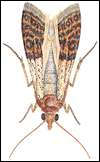
Size
8-1 1mm overall body length.
Markings
Light beige forewing with darker brown hindwing.
Location
Adult moth often seen resting on infested stock and on walls etc. nearby.
Detection
Visual sightings of adults and larvae, frass, webbing.
Plodia interpunctella is thought to have got its common name,’ Indian meal moth, from the United States, where it was recorded as a pest of meal made from Indian corn’, also known as maize. It is perhaps, like the maize or corn itself, of S. American origin, but is now cosmopolitan. In this country it first attracted attention as a serious pest of dried fruit, particularly of currants, raisins and sultanas. The moth is regularly brought into Great Britain in cargoes aboard ships and aircraft, and as a result is to some extent endemic in our warehouses.
Biology
Although this species of moth is a well known pest, there is surprisingly little information about its status as an established insect in this country. Similarly, it’s life-history and ecology is not as well known as, say, the Mill Moth, Ephestia spp. Food quality and temperature are the main factors affecting the length of the life-cycle and the rate of reproduction. Plodia has a complete metamorphosis. The minimum period from egg to adult is six weeks under ideal conditions, but extends to many months when food and temperatures are less favourable. The final larval stage wanders some way from the food source in order to pupate.
Reasons for control
The Indian Meal moth is becoming a major pest species in food processing plants and health food shops, requiring destruction of infested product and insecticidal treatment. In warmer climates than ours, such as southern Europe, it attacks a wide range of commodities: sultanas, raisins, currants, figs and fig paste, dried apricots, hazel-nuts, apricots, wheat bran and lentils. Any such products in storage in this country have the potential for infestation. This species seems also to be fond of chocolate!
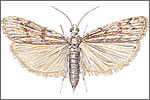
Size
Head to Abdomen tip 15-20m. Wingspan 30-38mm.
Markings
Adults white thorax, white wings, brown-banded abdomen (female) all brown abdomen (male). Larvae (caterpillars) black with white side marks and orange spots. Very hairy.
Location
Mainly South or Midlands. Found in trees and bushes .
Detection
Visual sightings of adults, or more likely caterpillars. Tents’ woven from silk. Customer complaints of irritation due to detached hairs.
The Brown-tailed moth was first reported as a pest in the year 1720 with outbreaks occurring irregularly, often missing several years. The moths until recently were normally confined to south eastern England and the last epidemic was in 1993.
Biology Adult Moths
The adult moths of both sexes have paper white wings and a large brown body. The female differs slightly from the male by having a mass of brown hairs on the, extremity of her abdomen, but both species are unremarkable in their appearance. The adult moths fly mainly during July! August. After mating, the female will lay her eggs on a suitable food plant, covering them in abdominal hairs as she does so. Laying to hatching takes 4-6 weeks, dependant on temperature.
Larval Stage (Caterpillar)
The caterpillars are black with white side markings and orange spots near the tail and are covered in thousands of tiny hairs giving them a bristly appearance. These hairs can detach, and blown on the lightest breeze can travel some distance.
They are extremely irritating to both humans and animals, causing allergic skin, eye and respiratory tract symptoms. They form ‘tent’ structures of silk to provide shelter during inclement weather or at night. The caterpillars, which emerge in late spring to early summer have voracious appetites and consume vast quantities of young leaves on trees and shrubs causing serious defoliation in a few days. The caterpillars will attack a range of plant species, including fruit trees, Hawthorn, Buckthorn, and Blackthorn, but other species may also be damaged.
Pupae
During the month of June the pupae are formed when the caterpillars cease to be mobile. This seemingly ‘dormant’ pupal case is covered in a large mass of brown silk between the leaves. Pupation takes around a month, and emergence of many adults can occur simultaneously, to maximise the chances of successful breeding.
Lifecycle
Stage 1 – Egg stage, laid in groups on leaves by female caterpillar.
Stage 2 – Caterpillars. Mobile stage, feed on leaves and undergo several skin changes. Very damaging to tree or bush foliage.
Stage 3 – Chrysalis / pupa Apparently ‘dormant’ stage, only capable of a slight jerking movement of the abdomen. Whilst in this stage many body changes occur, turning eventually into the imago.
Stage 4 – Imago. The flying adult moth.

Size
Adult males about 60cm from nose to tail. Weight up to 1.5 kilograms.
Markings
Dark brown to black, but can be grey white. Lighter underside with light chin patch.
Location
Surprisingly widespread throughout Britain, mainly by bodies of water.
Detection
Sightings of live animals, runs, remains of animals. Smell and dark droppings.
Mink are not native to this country, having been introduced from North America in 1929 for breeding on fur farms. Due to escapes and “liberation” by animal rights activists however, they soon colonised our native rivers after the first reported breeding incident on the river Teign in Devon in 1957.
Biology
The mink is similar in appearance to our native stoat and weasel but is considerably larger, with males weighing an average of over a kilo. Colour can vary greatly from the usual dark brown to black through to grey and even white. Most colour variations have a white chin patch, sometimes with larger patches of white on the under parts of the body. Males can reach a length of 600mm from nose to tail with the females being somewhat smaller and only about half the weight of the male.
Mink are solitary animals for most of the year, only briefly coming together for mating in early spring. Five to six young are born between 6 – 7 weeks later and are weaned at 8 weeks, but they do not attain full size until four months. These young remain with the mother until late summer when they disperse to lead a solitary life until early the nest spring when they are mature enough for breeding. Mink may travel some 30 miles to set up their own territory.
Mink are voracious hunters which is why the need for control is so great – they will devastate wildlife from any location. Mink will take any prey they can overcome which can vary from small fish to large cygnets. Rabbits, rats, voles, fish and many ground dwelling birds quickly fall prey to any mink moving into new territory which is often en-route to a waterway of some description i.e. a small brook or large river. This does not deter the mink from travelling across country however and coming into contact with livestock in farmyards or pets in gardens. Some specimens are particularly bold and have even been known to enter houses! It is a little known fact that foxes often get blamed for the vast destruction that just one of these creatures can cause in a poultry unit.
Signs of Infestation
The first noticeable sign of infestation is the rapid reduction in wildlife, either due to slaughter or evacuation due to mink presence. Often the remains of kills can be seen on the water’s edge, with the mink’s characteristic foot prints also visible. The print is often seen in damp mud or sand, and is made up of a large lobed pad fronted by five toes (but sometimes only four show). The points of large claws should also be visible. Mink have partially webbed feet, and this can sometimes be seen in the pawprints. Dark ‘tarry’ faeces of approximately 7-9cm in length, 9mm in diameter and having a noticeable ‘twist and point’, can also be found, coupled with the pungent smell produced by these animals. In a long-standing infestation, regularly-used routes will be relatively easy to see.

Size
0.5 -1.5mm overall body length.
Markings
Varies considerably in colour, but often white or grey.
Location
Numerous habitats from houses to factories, farms etc.
Detection
Musty or minty smell, Visual sightings of adults (tricky).
The mite is not classed as an insect, but falls into the same group as ticks and spiders. These are tiny animals which are often virtually invisible to the naked eye, but when viewed under a hand lens, they can be seen to move, albeit slowly. Across the world, there are mites to suit virtually every ecological niche – some feed on vegetable matter, others are carnivorous or even cannibalistic. Many are predatory and some are even parasitic. Their biology and behaviour could fill a book and so just the salient points are summarised here.
Biology
A typical mite, such as the Flour Mite, Acarus siro, will lay up to 500 eggs in it’s lifetime. Upon hatching, they will pass through a six-legged larval stage. From this, the young move on to a number of nymphal stages (two in this case), before reaching adulthood.
The time period from egg to adult can be three weeks at 25°C, but much less at increased temperatures. This can lead to phenomenal population explosions, with many millions of mites appearing in a matter of weeks.
Some mites, the Flour Mite being one, have an additional stage in their lifecycle. This is known as the ‘Hypopus’ or resting stage. The hypopus is extremely resistant to changes in the environment such as drought, starvation and the introduction of a pesticide. Some people see it as a hibernation phase, and whilst this is a useful analogy, it is not strictly true.
Reasons for Control
There are nearly as many reasons to control mites as there are species. Often it is due to a commodity becoming infested or a piece of machinery requiring a fumigation. Sometimes it is for public health or medical reasons, as many species, such as bird mites can bite humans. On other occasions it is because mites and their droppings are known to cause adverse reactions such as Baker’s Itch and Asthma. Indeed, a protein from droppings of the house dust mite, DER P1, is thought to be a major causative agent in the modern Asthma epidemic.

Size
About 11-18cm from nose to tail. Weight around 100 gramme’s.
Markings
Black smooth velvety hair over most of the body. No visual differences of sexes.
Location
Widespread throughout Britain, but absent from Ireland.
Detection
Sightings of live animals, mole hills, runs/tunnels. Subsidence. Moles are abundant throughout Britain except for Ireland, and they spend the majority of their lives below ground Their tore limbs are well-adapted for burrowing in earth, being shovel shaped and turned outwards to facilitate earth removal. Moles have poor eyesight their eyes being greatly reduced in size. They are about 15cm in length, have a shiny black short coat with a velvety appearance and a short thin tail.
Biology
Moles breed from February to June with only one litter of young being the norm. The gestation period is about 4 weeks and the young are born pink skinned, blind and wholly dependant on their mother. The average litter size is 4 but anything from 2 to 7 are born in a specially constructed extra large mound of earth called a “fortress”.
The young mature quickly and leave the nest after about 5 weeks. Moles do not hibernate and are extremely active creating and extending a network of tunnels below ground. These tunnels are regularly patrolled in search of earthworms, their main food but insect larvae and slugs also occasionally form part of their diet.
Signs of Infestation
Moles are solitary and very territorial, only coming together to breed. The presence of moles is usually noted by the appearance of casts of earth thrown up from tunnels excavated below ground. The quantity or mole hills is not an indication of the number of moles present.
Moles are so fiercely territorial that one mole’s territory might be as much as 200 m2 (1 imperial acre), and even in the largest of garden situations, many casts of earth will be the result of one mole. Moles rarely traffic above ground and droppings or surface runs never occur.
Mole hills are unsightly dotted over ornamental lawns and are particularly damaging on golf greens, bowling greens and playing fields. Damage to mowing machines can occur from excavated stones in mole hills, contacting with mower blades.

Description Order
Diptera (‘two-winged’)
Characteristics
Adults: Globular head, a large part of the surface of which is taken up by the compound eyes; a pair of antennae, which are about three times as long as the head, are somewhat hairy in the female and quite bushy in the male; this difference provides a ready means of distinguishing between the sexes with the naked eye. Also on the head a pai palps, one on each side of the proboscis; in the female they are smooth, in the male they have tufts of bristles. Mouthparts form a long thin projecting proboscis which in the female are designed for piercing; there is a single pair of membranous wings which bear tiny scales along the veins as well as a fringe of scales along the hind margin. The wing venation is also typical with 6 longitudinal veins of which the second, fourth and fifth are forked; tarsi are 5-segmented.
Larvae
Entirely aquatic. They have a well developed head followed by a swollen unsegmented thorax; abdomen is segmented and there is a pair of spiracles on the last but one segment through which they breathe at the water’s surface. Tufts of bristles arise from many of the body segments.
Pupae: Comma-shaped with a curved tail which ends in a pair of paddles; head is equipped with a pair of respiratory trumpets through which the pupa breathes. The fused head and thorax show traces of the wings and long legs of the adult which are developing inside.
Family: Mosquito. Aedes spp
6.5mm wingspan
Culicidae (mosquitoes) Metamorphosis is complete with egg, larval, pupal and adult stages. There are about 3000 species of mosquitoes in the world.
Sub-Family: Anophelinae Genus: Anopheles spp
Characteristics
Wings speckled with dark and pale-coloured scales; there are no scales on the abdomen; female palps almost as long as the proboscis, the male palps are usually clubbed. When resting the abdomen is held at an angle from the surface on which the mosquito is standing, forming a straight line with the proboscis (e.g. Anopheles gambiae).
Sub-Family: Culicinae
Characteristics
Female palps are short and the abdomen is covered in scales. The resting stance is parallel to the surface.
Genus: Culex spp.
Characteristics
Vary in size but all have a blunt tipped
abdomen and usually lack distinctive markings
on the body or wings
(e.g. Culex quinquefasciatus).
Genus: Aedes spp
Characteristics
Medium to large; most have pointed abdomen and well separated eyes; usually distinctly marked by patches of dark and light.
scales; often general appearance of black with silver markings (e.g. Aedes aegypti).
Genus Mansonia spp
Characteristics
Medium sized and heavily covered in scales which are of mixed colours giving a ‘salt and pepper’ appearance. Larvae are rarely seen since they remain submerged and pierce plant tissues with their breathing siphons to obtain oxygen (e.g. Mansonia uniformis).
Note
There are several other Genera of mosquitoes some of which are implicated in disease transmission but others are of no risk to humans. Space does not allow consideration of all the other Genera here.
Distribution
Mosquitoes are ubiquitous insects, they can be found in nearly every type of climatic region of the world from the arctic regions to the tropics, surviving severe winters or dry seasons depending on the region. Depending on species they can be found breeding in all types of water; from heavily polluted, to clean; from small collections of water in tin cans, to pools or streams; such is their adaptability. Their distribution is increased and aided by transport systems such as boats and aircraft and non-indigenous species have been introduced to new territories in this way, even infected mosquitoes have been transported to temperate climates, thereby transmitting tropical diseases.
Significance
Primarily a seasonal biting nuisance in cooler climates but in the tropics they can also be major vectors of disease. They can transmit many diseases to both humans and animals, e.g. malaria, filariasis, yellow fever, encephalitis, and dengue fever. Only a few species of mosquitoes are implicated as vectors of human diseases. It is those which utilise humans as their primary host and are also willing to enter houses in their pursuit of a blood meal which are the most important. Some species do not feed on humans at all but utilise other mammals birds or even reptiles as hosts.
Statistics show that 270 million people are infected with malaria alone and of those up to two million will die annually. It is this that makes the mosquito the most dangerous creature in the world.
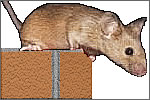
Size
7-9cm(head+body length). TaiI 80% body length. 10-25g (average about 15g).
Markings
Grey/Brown fur, slightly lighter undersides.
Location
Just about anywhere that man is found, and more.
Detection
Customer will report live sightings, scuffling noises, droppings and gnawed goods, smell. Nesting materials sometimes seen.
Biology
Rodents are well-studied, and in-depth facts of their biology, behaviour and treatment should be sought. Important details are summarised below.
The house mouse arrived in Britain around the 10th century BC, but originally it was a wild species, coming from the Steppes of Russia and the surrounding areas. Although it is not originally a native species, it has made itself very much at home, and is now common throughout rural and urban Britain. It associates itself with man in almost all his environments, but it is not found in sewer systems.
The mouse is a rodent, one of over 1500 species of mammals belonging to this group, although only 15 are present in Britain. It can be easily placed in this group by looking for the single pair of upper and lower front teeth called incisors. They have no canine or premolar teeth, but they do possess molars at the rear of the jaws. There is a noticeable gap between the incisors and the molars, known as the diastema.
The incisor teeth of rodents grow continuously throughout the animal’s life and so a mouse must gnaw on objects to keep them worn down and at a manageable length. The molar teeth do not grow continually. The incisors are strongly curved and have enamel on one side only, allowing a razor sharp edge to develop. This means that mice can bite through wood, soft metals and even soft stonework with ease – modern food packaging presents no problems.
Reproduction rates of mice are impressive, and in theory nearly 2000 offspring in one year could result from just one pair of adults (1 doe + 1 buck), given ideal conditions. After mating there is a gestation period of 21 days before 5-6 young are born. At birth, baby mice weigh just 1 gramme. They are weaned after only 3 weeks and sexually mature after only 8-12 weeks. Each female can have up to 10 litters in a year. Mice can live up to 2 years in the lab, but usually live less than 12 months in the wild. They are fiercely territorial.
Like all rodents, mice require a balanced diet, and can be thought of as omnivores. Historically, mice tended to feed on products of cereals and grasses, and so they tend to prefer rodenticide’s containing grains etc. They can also eat a wide range of other foods including vegetables, fruits, fish, insects and meat. They are also cannibalistic, and will eat each other. Local food preferences should always be taken into account when planning a treatment regime. Mice are inquisitive but erratic feeders, and will eat 3-4g a day. They will drink when a water source is available, but they can get sufficient moisture from their food.
Mice have the same 5 senses as humans, but their touch, smell and hearing are particularly keen. They cannot see colour, but are good at detecting movement.
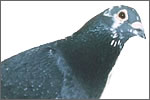
Size
30-34cm overall body length. Weight varies from 250 to 550g, but is typically about 350g.
Markings
Varies considerably in colour, from blue-grey, through blues, purples, dark reds and mottled patterns to charcoal.
Location
A wide variety of habitats, from the deepest rural setting to the centre of a city. Closely associated with human habitation.
Detection
Visual sightings of adults. Droppings. Nesting materials. Smell. Presence of other pests such as bird mites or Dermestes beetles.
The feral, town or city pigeon is amongst the most widespread of creatures, being found worldwide and throughout Europe. In this country it can be found in almost all environments including towns and cities, farmland, parks, golf courses, moorland and woodland. All attempts to eradicate them have failed.
Biology
There are over 300 species of pigeons and doves around the world. Feral pigeons are believed to have descended from domesticated strains of the rock dove. In the wild it then interbred (and continues to interbreed) with racing pigeons and pigeons from bird fanciers’ lofts.
These birds are capable of breeding year-round, but peak season runs from March to late August. Nests can be found on virtually any ledge or horizontal surface which provides a modicum of shelter. The nest is usually made of grass and twigs, but many pest technicians will recount stories of nests made from plastic, wire and other scrap materials. The nest becomes more substantial with each brood raised.
A normal clutch consists of two off-white eggs laid on consecutive days. These are incubated for 18-19 days, and it can occur that the female incubates the eggs at night and the male take over during the day. Pigeons produce a protein-rich pigeon milk’ – a cheesy curd that sloughs off from the lining of part of the crop. This is initially all the nestlings need. Later, at feeding times, the adults regurgitate food they have gathered and stored in the crop. Young are fed twice a day in the morning and evening. Fledging takes place after 30-32 days and a further clutch of eggs can be laid when the first young are only three weeks old. It is possible for feral pigeons to produce 9 broods a year, but 4-5 is more normal.
Reasons for Control
Pigeons are often controlled more because of their nuisance value than because of any serious damage they do. Complaints can include the noise they create from cooing and scratching (especially in the early morning and evening), damage to cars, domestic premises, monuments and commercial properties due to droppings, the resultant smell, and of course the potential slip hazard. Pigeons can also carry several species of mites which can cause severe irritation of the skin. Numerous secondary insects are found infesting the droppings.
Another reason for control is the potential spread of disease from pigeons. The pigeon is often called the flying rat’ and carries the most of the same diseases and many more besides. Their presence in around food producing factories, restaurants and cafes, food shops, farms and docks, hospitals and other such buildings must not be tolerated.

Size
Adult rabbits are about 40cm long (head and body). 800 – 2000g (average about 1 700g).
Markings
Grey/Brown or black fur, slightly lighter undersides.
Location
Farmland, golf courses, gardens, railway embankments, allotments etc.
Detection
Customer will report live sightings and droppings. Burrow entrances will be visible and gnawed vegetation along with runs will be seen.
Rabbits were first introduced to this country by the Normans as a food source, but escapes soon occurred and they quickly colonised the surrounding countryside. The fur of these animals was also a valuable by-product and was used extensively for clothing. Colour can vary slightly from light brown to grey through to black, but generally they are brown with long dark hairs giving a well camouflaged appearance. An adult will weigh in the region of 1.7kg but larger specimens often occur. The bucks (males) have a broader head and heavier body than the does (females) and often show signs of fighting for dominance of a warren, with ragged and torn ears being common.
Biology
Breeding mainly takes place between January and July but can occur during any month, with young females capable of breeding at 3 – 4 months of age. Gestation is 28 – 30 days with an average litter size of 5. Females are capable of breeding 4 – 5 times a year in ideal conditions. Mating and conception within 24 hours of parturition usually occurs with ovulation being induced by mating.
The young are born hairless with their eyes closed in a nest chamber called a stop’ which is prepared by the doe. This can be within the main warren, but more commonly it is a short distance away, and is a short dead-ended tunnel. The entrance is blocked when the doe has completed feeding (which takes place at 24 hour intervals), to prevent predation. The stop contains dry grass and bracken and is lined with fur from the doe’s underparts. Eyes of the young rabbits open at about 10 days and weaning takes place at 3-4 weeks of age.
Rabbits are very clean animals and spend a great deal of their time grooming and cleaning their fur in much the same manner as cats. Defecation or urination never takes place within the burrow system – all faeces being deposited outside the warren with the average being 50 hard, round pellets in a 24 hour period. Rabbits have a techniques known as ‘refection’, where the softer encapsulated faeces are re-ingested to obtain the maximum nutrition. Signs of Infestation: Rabbits feed by grazing, taking any young shoots close to cover and nibbling them down squarely to 10mm or so above the ground. In cereal crops extensive grazing can occur and crop loss can run into many £1 000’s. Grazing on vegetables or flowers in domestic gardens can also be infuriating. Rabbit damage is not limited to feeding, but their burrowing in areas such as golf courses, graveyards, railway embankments and farmland can cause much disruption.
Apart from the visual damage caused by grazing, a number of small scrapes may be noticed, where attempts to obtain roots have taken place. These signs, and large amounts of hard round droppings can easily be seen. Often, on well established routes to feeding areas runs are easily visible and they can be followed from the warren to a chosen feeding ground. Damage to trees or shrubs can also be seen in the winter months when food is short and this can be extensive to smooth barked species. Trees can be killed by this stripping of the bark unless a guard or fencing is erected for protection.

Size
9-28cm(head+body length).Tail 60% body length. 1 00-500g (average about 350g).
Markings
Grey/Brown or black fur, slightly lighter undersides.
Location
Just about anywhere that man is found, and more.
Detection
Customer will report live sightings, scuffling noises, droppings and gnawed goods, smell. Nesting materials sometimes seen. Britain is host to two species of rat, Rattus norvegicus (the Brown or sewer rat) and Rattus rattus (the Black or ship rat).
The Brown Rat is the newcomer to our shores, arriving several hundred years ago from Asia. Weighing 100 – 500 gramme’s, its upper parts are dark brown becoming lighter brown to grey or even white on the under parts. The tail is shorter than the head and body and the head and face are quite blunt in appearance.
The Black rat is far less common and restricted to only 3 major ports. Its appearance is sleeker with a body weight between 100 – 300 gramme’s with brown to black fur, large almost hairless ears and a tail which is longer than its head and body. This enables it to be very agile and an excellent climber which gives rise to its other name “Roof Rat”.
Biology
Important details of rat biology and behaviour are summarised below. The life expectancy of a wild brown rat is approximately 10-14 months in which time the female will typically breed between 5 and 7 times, with an average litter size of between 7 and 8 young. Breeding can occur throughout the year depending more on the availability of food and harbourage than on weather conditions. Around 800 offspring from one pair or rats is possible, under ideal conditions. Both species are most active at night but may be seen in search of food and water during daylight hours.
Immense damage can be caused by rats feeding in warehouses, factories, shops and homes due to both quantities of food consumed, contamination by faeces and urine, and damage by gnawing. Contamination and possible introduction of microorganisms which can cause food poisoning, such as Salmonella make this rodent a major public health pest. Remember rats carry Weil’s Disease (Leptospirosis) which can cause serious illness.
Many signs of infestation may occur, droppings being the first possible sign followed by gnawing. Damage to fabrics, excavations around or under buildings, well worn runs through undergrowth or smear marks (a dark mark caused by body grease) over surfaces which are crossed regularly are other tell tale signs. Where infestations occur near water courses holes will often be present in the banks as this offers an excellent escape route as rats are accomplished swimmers.
Rats have five senses like humans, with particularly well developed hearing, smell and touch, but they are colour blind. They do have good movement detection.
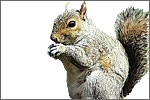
Size
About 25cm or so. Tail nearly as long as body. Weight around 500g.
Markings
Grey with a whiter belly, but grey turns browner in summer.
Location
Becoming widespread throughout Britain.
Detection
Sightings of live animals, droppings, bark stripping, kibbled cones / nuts, scattered food remains, dreys, tracks (footprints) in soft mud or snow.
Biology
Squirrels are well known to most of us, and are easily recognised. They can be quite prolific in their reproduction, with two breeding seasons per year. After a gestation period of 61/2 weeks (45 days), the first litter is born in late February or early March. A typical litter contains 3 or 4 young. If a second litter is born, it usually occurs at the end of June or into July.The young are weaned at about 10 weeks old, and leave the nest soon after.
The squirrel nest is known as a drey, and is made of twigs and leaves, and can sometimes be lined with grass. When dreys are made in roof spaces, the squirrels will gather all manner of fabrics, gnawed cardboard etc. to act as nesting materials.
Squirrels have a surprisingly wide and varied diet, eating foods such as fruits, nuts seeds, plant and tree buds, fungi, and new shoots. They will also take birds’ eggs and even the nestlings. Obviously, bird food etc. put out in gardens becomes an easy target, but because many people like squirrels, the food is put out specifically for them.
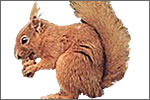
Size
About 25cm or so. Tail nearly as long as body. Weight around 500g.
Markings
Red squirrels have easily visible ear tufts, and are much redder and smaller than the grey squirrel.
Location
Becoming widespread throughout Britain.
Detection
Sightings of live animals, droppings, bark stripping, kibbled cones / nuts, scattered food remains, dreys, tracks (footprints) in soft mud or snow.
Biology
Squirrels are well known to most of us, and are easily recognised. They can be quite prolific in their reproduction, with two breeding seasons per year. After a gestation period of 61/2 weeks (45 days), the first litter is born in late February or early March. A typical litter contains 3 or 4 young. If a second litter is born, it usually occurs at the end of June or into July.The young are weaned at about 10 weeks old, and leave the nest soon after.
The squirrel nest is known as a drey, and is made of twigs and leaves, and can sometimes be lined with grass. When dreys are made in roof spaces, the squirrels will gather all manner of fabrics, gnawed cardboard etc. to act as nesting materials.
Squirrels have a surprisingly wide and varied diet, eating foods such as fruits, nuts seeds, plant and tree buds, fungi, and new shoots. They will also take birds’ eggs and even the nestlings. Obviously, bird food etc. put out in gardens becomes an easy target, but because many people like squirrels, the food is put out specifically for them.

Size
3-18mm overall body length.
Markings
Adults mid-brown in colour. Can be shiny. Larval stages are white/straw coloured. Soldiers have enlarged mandibles (jaws).
Location
Timber, both in the wild and in construction/furniture etc.
Detection
Visual sightings of adults. ‘Sawdust’ on the floor. ‘Arteries’ made out of wood pulp and mud.
Termites are among the oldest insects in the world, with fossilised remains at least 55 million years old being found. The name Termes” is a Roman term meaning wood worm’. Although considered a tropical pest, they are becoming widespread throughout Europe, and we even have a colony in the UK. Originally a wild species found in dead and fallen timbers, termites have acclimatised to man’s world of wooden, or part-wooden buildings. They can be found inside or outside, attacking window and door frames, structural timbers and garden posts, and even paper in books. Of all species, the subterranean termite probably causes the most damage in the US. In the UK, termites are not (yet) established as a pest species.
Biology
There are numerous species of termite occupying many ecological niches., but their biology is similar. The main points are summarised here. A mating flight or swarm takes place when atmospheric conditions (temperature and humidity) are ideal. As a rule, termites avoid light. The winged reproductive’s, known as ‘alates’ move away from their instincts and seek light and space. After a short and weak mating flight, the wings break off at a pre-designed fracture point’ and the insects spiral to earth. Alternatively, they land and the wings then become dislodged. Even though they have undergone a specific mating flight, the actual mating often takes place on the ground, with pairs then attempting to start new colonies. These are the primary and permanent queens and kings.
In time, the body of the queen becomes enlarged because of the enhanced development of the ovaries and associated glands. Queens in the tropics can reach over 75mm (3+”) in length. Enlarged queens develop a stripy abdomen due to the body segments stretching apart. The primary queen reaches maturity in two years. Most workers only live a few months, but some queens can live up to 25 years. Their egg laying capacity is legend, with reports of 6 eggs a minute (8,460 a day or 3,153,000 per year) being laid. Reticuiltermes is more modest, laying 6 – 12 , the first batch, in a few hours, but going on to lay many thousands. In addition, in an established nest there are ‘supplementary queens’, who boost the colony by laying several dozen eggs a day.
Young termites are fed on a prepared and predigested food, and only later are they capable of eating wood. When consumed, the cellulose in the wood is digested and the lignin (the material that stiffens the cell walls in wood) is excreted. Young nymphal termites develop into one of three ‘castes’ – workers, soldiers or alates. A typical nest will contain all three castes in varying numbers depending on the season. Nests can range from a few thousand individuals right up to alleged figures of several million in the huge tropical mound nests seen in Africa.
Moisture is very important in a termite’s life, especially for subterranean species. When an infested piece of wood is broken open you can see what appear to be white maggots with legs. These are the workers. Since the outer covering of this worker is thinner than in most other insects, it is less effective in conserving body moisture, and for this reason, the worker termites live in the dark, away from the drying effects of the sun. The worker termite needs moisture – part of this comes from feeding and metabolism, and part from the soil surroundings.
Reasons for Control
Termites were not created for the sole purpose of providing a livelihood to American pest control technicians! These insects are an important and serious pest of timbers, both structural and decorative. In addition, they attacks furniture and other wooden goods. Varnished or polished woods are simply eaten from the inside out. Often, A householder will not know they have a problem until they put their hand or foot through a piece of infested wood, when the paper this outer surface and dozens of internal galleries are all that is left of a once-solid structure.
Where structural timbers are affected, serious weakening can occur, resulting in expensive repair work or even demolition. It is said that a nest of 60-80,000 individuals can eat up to a pound of wood a day.

Size
Head to Abdomen tip 10-20mm. Wingspan 25- 40mm.
Markings
Adults wasps have characteristic yellow and black bands on abdomen, with a distinct waist between thorax and abdomen. Head features are commonly use to identify different species.
Location
Country-wide. Nests found in hollows in trees, roof spaces, voids and cavities. Adult wasps found around sweet foods and drinks, and near skips and bins etc.
Detection
Visual sightings of adults, complaints of a ‘suspected’ nest. Stings.
Eleven species of true wasps are found in Europe, while only two, Vespula vulgar/s and Vespula german/ca, can be described as widely distributed pest species. The hornet, Vespa crabro, also attracts a considerable amount of interest but is seldom sufficiently common to constitute a true pest. Various species of bees are often confused with wasps on the basis of their black and yellow colouring. Owing to their ability to sting and their fondness for sweet material, feral honey bees occasionally achieve a similar pest status to wasps.
Biology
Both wasps over-winter only as queens. Common wasps are commonly found in houses in the spring and autumn as they are leaving and seeking a hibernation spot. German wasps typically over winter under the bark of dead trees. Having emerged from hibernation the queen will start to construct the nest in a hole in the ground, a hollow tree or similar artificial structures such as birds nest boxes, attics etc. She will lay 20 or 30 eggs and raise these first few workers by her own efforts and these workers will then take on enlarging the nest and caring for the immature stages to follow. Nest construction normally starts in earnest during June and the nest will reach a peak size in September of five to ten thousand workers. These workers will normally forage up to 400m from the nest in search of food (insects, spiders and carrion), fluids (sap, nectar and fruit juices) and nest building materials (wood pulp). The number of wasp colonies will vary considerably from year to year and from place to place. Peak densities of two nests per hectare have been recorded in ‘wasp years’. In the autumn new queens seek somewhere to hibernate while the rest of the colony dies out. Unlike honey bees, wasps never swarm.
The hazard of wasp stings is universal knowledge – very few people manage to avoid being stung at some time or another. In the UK around three people die each year from wasp stings, either as a result of respiratory obstruction following a sting in the mouth or throat or from ‘anaphylactic shock’.
Damage
Wasps chew through the skin of apples, pears, plums and other fruits in order to reach sweet pulp. When wasps are abundant, such damage can be severe to the commercial grower as well as the private gardener. Wasps and particularly hornets have been known to enter bee hives and eat the brood and honey, although this is fortunately not a widespread problem. Wasps chew wood to make pulp for their nests, and where this occurs on, for example, garden furniture, timber cladding on houses, etc it is sometimes seen as a problem.
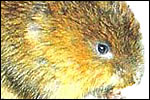
Size
18-22cm head and body length. 13cm tail. 200 – 350 gramme’s in weight.
Markings
Uniformly brown or black, sometimes with white patches.
Location
Banks of rivers streams, drains, ponds and canals.
Detection
Distinctive green droppings deposited in ‘latrines’ during the breeding season, burrows, woven nests, footprints, piles of chopped vegetation, grazed lawns around burrows. Water vole burrows are typically 4-8cm wide. (Rat burrows are larger (8-10cm) with a fan-shaped spoil heap outside, connected by well-trodden runs and tend to be higher up the bank than water vole burrows.
Commonly called the water rat, the water vole is a native British mammal often mistaken for the Brown (or common) rat, (Rattus norvegicus), but is distinctly different with it’s round face, hairy tail and unprotruding ears. They are rodents of the family Cricetidae, which includes Hamsters and Lemmings. Recent surveys have shown that this once widespread species is in serious decline throughout the United Kingdom, due to the loss and fragmentation of habitat and predation by mink. This has resulted in the legal protection of the water vole and it’s habitat under the Wildlife and Countryside Act 1981, as from April 1998.
It is not a serious pest in the UK, although it may occasionally debark trees. On the Continent, damage is more serious owing to it’s burrowing habits, which enable it to eat root crops in storage. In Russia, it is known to be a carrier of the causative organism of the disease Tularaemia.
Biology
Water voles generally live in burrows in the banks of slow-flowing watercourses where there is a high level of plant cover to provide them with shelter and food. They can also live in the banks of canals, ditches and ponds, and will make woven nests about the size of a small football in reeds and sedges. The burrow complex usually has at least one submerged entrance. Water voles are largely herbivorous, preferring grasses, sedges, rushes and reeds, but will also eat invertebrates.
The water vole is a very shy creature, requiring a great deal of cover around it’s burrows and over it’s runs. They will dive into the water if danger threatens. It is active during the day, unlike the rat which is largely nocturnal, but is rarely seen. Dawn and dusk are the best time to catch a glimpse of a water vole. Often the first clue that a water vole is present nearby is the ‘plop’ sound of them disappearing into the water from amongst the vegetation as you pass by. They have, however, become sufficiently tame in certain areas to steal the bait from fishermen’s bait boxes.
This species lives for 2-3 years. The breeding season water voles is from late March until early October, during which time all adults will hold discrete territories along the bank. Males hold relatively large territories which will encompass the territories of several females. Each territory is marked by a series of latrine sites, where the animals regularly leave their droppings and stamp to leave their scent.
The droppings are about 1cm long, regularly shaped and rounded at the ends. They are normally green in colour and relatively odourless. When broken open they are clearly green inside. Another definitive sign of the water vole is the grazed ‘lawn’ often seen around the outside of a burrow on top of a bank. This is due to heavily pregnant females not venturing far from the burrows and simply popping their heads out and grazing around the edge of the burrow.
During the winter months, no breeding occurs and the animals no longer hold territories. They also become less active. This makes it more difficult to accurately determine whether water voles are present or not. The signs of rats will, however, still be visible, and so care must be taken not to mis-identify an bank as being inhabited just by rats when water voles are present as well.
Legal Protection
The water vole is now listed on Schedule 5 of the Wildlife and Countryside Act 1981 (as amended in April 1998) in respect of Section 9(4) only. Thus the habitat of the water vole is protected and the animal itself is protected from disturbance. This makes it illegal to:
1) Damage, destroy or obstruct access to any structure or place which a water vole uses for shelter or protection.
2) Disturb a water vole whilst it is using such a place.
Offences under Section 9 carry a maximum penalty of a fine not exceeding Level 5 on the standard scale (in 1998, this was equal to £5000), and, in addition, the courts may order the forfeiture of any vehicle or other item that was used to commit the offence.
This information has been prepared by Mike Dean at emec, an ecological consultancy based at The Old Ragged School, Brook Street, Nottingham NG1 1 EA Tel 0115 964 4828 Fax 0115 964 4829 e-mail emec@dial.pipex.com Photographs etc courtesy of Mr A Strachan Further information can also be obtained from English Nature.
If you would like more information on the Water Vole Recovery Project please contact BBONT, The Lodge, 1 Armstrong Road, Littlemore, Oxford, OX4 4XT. Tel 01865 775476. Website www.wildlifetrust.org/bbont Registered Charity no. 204330
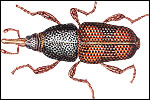
Description Order
Coleoptera (‘sheath-wings’)
Characteristics
Forewings hard and leathery, meeting along mid-line of dorsal surface; hindwings membranous, sometimes lacking; biting mouthparts; well developed thorax; complete metamorphosis with egg, larval, pupal and adult stages.
Family: Curculionidae
Insects with cylindrical bodies and a pronounced rostrum (snout) equipped with mouthparts which is used by females as a boring tool; elbowed, clubbed antennae set on rostrum; 4-segmented tarsi.
Species characteristics
Grain Weevil (Granary Weevil) (Sitophilus granarius).
Adults, 34mm long; colour: dark brown, nearly black, with shiny appearance; 8-segmented antennae; prothorax with distinct oblong/oblong-oval punctures; hindwings absent.
Rice Weevil (Sitophilus oryzae)
Adults, 2-3.5mm long (average 2.5mm); colour: dark brown, nearly black, with four clearly defined reddish spots on the elytra; less shiny than the Grain weevil; 8-segmented antennae; prothorax with round or irregular punctures; hindwings present.
Maize Weevil (Sitophilus zeamais)
Very similar in appearance to the Rice weevil with the characteristics described above, except that the insects are longer, adults reaching a length of 3-3.5mm (average 3mm).
Distribution
Grain weevils are encountered in all temperate and warm-temperate climates and are widely distributed in grain stores throughout Europe. Infestations arise as a result of their regular importation in grain and cereal products and from the fabric of vehicles or buildings used for the transportation and storage of these and other vulnerable commodities. Sacks, too, are an important source of infestation, the insects finding harbourage in the seams and weave.
Being well suited to temperate conditions the species will breed readily in Europe and there may be three or more generations per year in unheated conditions. Both adults and larvae are cold-hardy.
Rice and Maize weevils are widely distributed in tropical and sub-tropical areas and will be carried to temperate areas on imported commodities. The Maize weevil will breed on maize in the field, but the Rice weevil only breeds in stored grain. Both insects are less cold-hardy than the Grain weevil and will not normally overwinter in unheated premises or grain stored at normal temperatures.
Significance
Grain weevils are important pests of farm-stored grain. They are frequently regarded as primary pests of grain since they are able to infest otherwise undamaged grain. Grain weevils will also attack other hard cereal products, e.g. macaroni and spaghetti. Fine cereal products are unsuitable for breeding purposes unless they become caked.
The following damage may be caused
I) Reduction in the weight and quality of grain as a result of the larvae feeding on the endosperm. The germ is not always attacked so germination may take place, producing a weak seedling which is vulnerable to attack by moulds, bacteria and other insects. Both larvae and adults will feed upon grains.
II) Tainting with white, dusty excreta which contaminate the product as well as rendering it unpalatable.
III) Heating of the grain, accelerating development of the insects and making the commodity liable to caking, moulding and even germination temperatures may be attained which actually kill the insects.
Weevil-damaged grain can be readily recognised by the presence of large holes which are the exit holes of the emerging adults. Some idea of the huge numbers of weevils that can be generated is provided by the results of one study in which, 5 weeks after wheat was infested with larval forms, adults were seen to be leaving the grain at a rate of 100 per kg per day.
Life-Cycle
The Grain weevil can only breed in grain with a moisture content of more than 9.5% and at temperatures within the range 13-35°C. The female lays about 200 eggs at a rate of 2-3 per day depending upon temperature and humidity, placing each one in a small hole bored in the grain and sealing it in with a mucilaginous plug of saliva. At 18-20°C the eggs hatch in 8-11 days to give small, white, legless larvae which feed on the endosperm of the grain. Only one larva develops in small grains such as wheat and rice but large grains such as maize will support the development of several. Larvae are never free-living and develop entirely within the grain.
They moult four times, finally pupating within the grain after 6-8 weeks. The adults emerge after a further 5-16 days and will live for about 9 months. If disturbed they will feign death by drawing their legs up to their bodies and remaining still. At 15°C and a grain moisture content of 11.3% the full life-cycle takes 6 months.
The life-cycles of the Rice and Maize weevils follow a similar course to that of the Grain weevil.
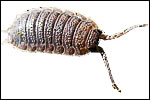
Size
Up to 15mm overall body length.
Markings
Woodlice are grey to dark brown in colour – paler speckling on some species.
Location
Generally a domestic garden, horticultural or agricultural species. When indoors, found in damp areas such as basements etc.
Detection
Visual sightings of adults. Droppings similar to mouse droppings, but ‘angular’. Chewing of leather, paper, wood and other natural fibres.
Woodlice are part of the Class known as Crustacea, (Order: lsopoda). The small plated creatures are said to resemble miniature armadillos. They have many common and regional names – for example, in Scotland they are called ‘Slaters’ after their colour and the appearance of the body segments, whereas in the ‘States they are called ‘Pillbugs’ after their ability to roll up into a tight ball when threatened. Members of this Order are found in many areas of the world, and are common throughout Europe. They are particularly widespread in the UK, with 35 species represented. They favour a diet made up of materials of plant origin, and as such are common in gardens, associated with damp and rotting vegetation.
Biology
The woodlouse is not an insect, but a land-living crustacean. As such, some of their biology is different to insects. One of the main aspects is their breathing. Insects have a series of internal branched tubes linked to external air-exchange holes (spiracles).Woodlice are much like their sea-dwelling forebears, having gills in the form of thin-skinned appendages on the legs, and a damp skin surface for oxygen transfer. This arrangement limits their habitat, which must remain damp in order for them to breathe properly. They do not have the waxy outer cuticle of insects, and can dry out in a matter of hours in a dry room.
Woodlice do not have a breeding season as such, but do tend to reproduce in Spring and Autumn. Many species can reproduce from half size onwards. Females produce up to 200 eggs (but averaging 40-50 per brood), which are held within her body in a special brood pouch until hatching. When first emerged, the young woodlouse is pearly white and about 2mm long. At this stage, they have six pairs of legs. All species grow by moulting, and can go through up to ten moults before reaching maturity. Larger woodlice (moult three and above) have seven pairs of legs. As with most creatures, growth is regulated by food supply, harbourage and temperature. It can take over a year for this species to reach full size, especially with the British climate.
Reasons for Control
In the main, woodlice can be classed as ‘casual intruder’ species, posing very little threat either to goods or public health. In some areas, sufficiently large numbers can become a pest of young plants. Occasionally, they can become an agricultural pest, attacking young shoots and some root crops, but this is unusual. Many instances of control are carried out simply because customers find them ‘unpleasant’.